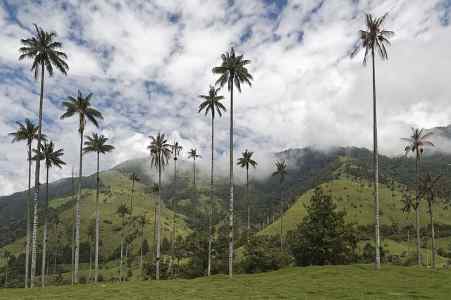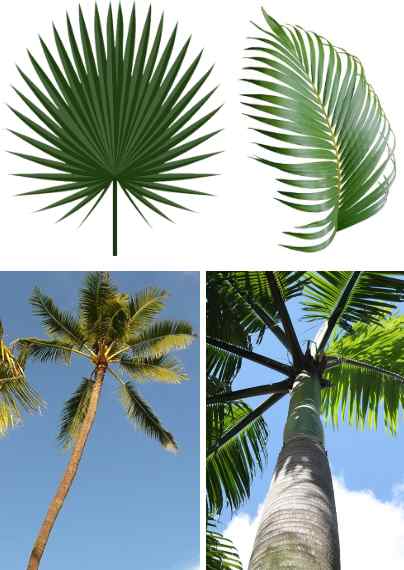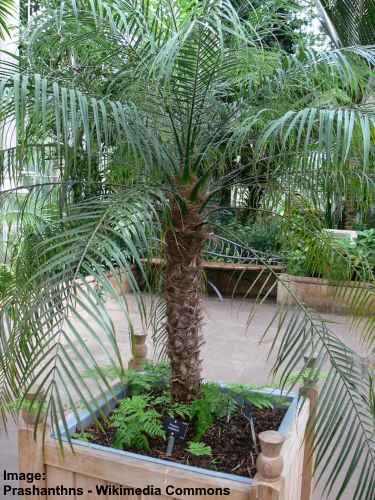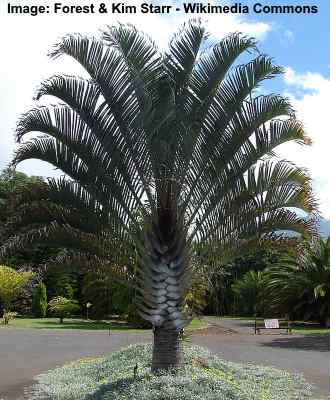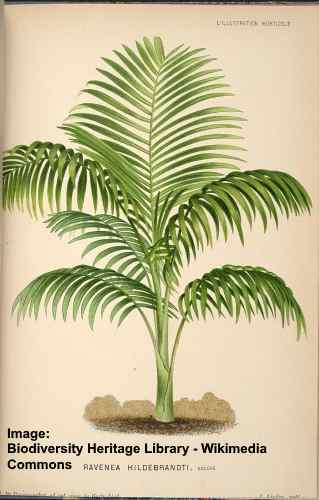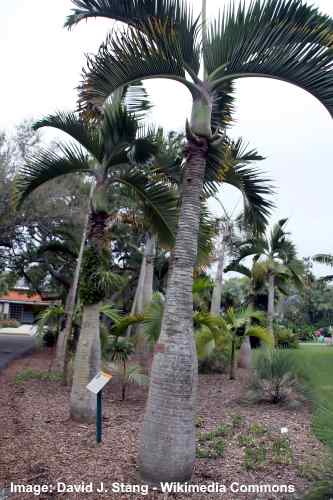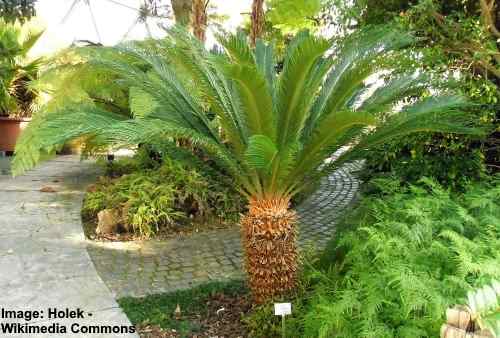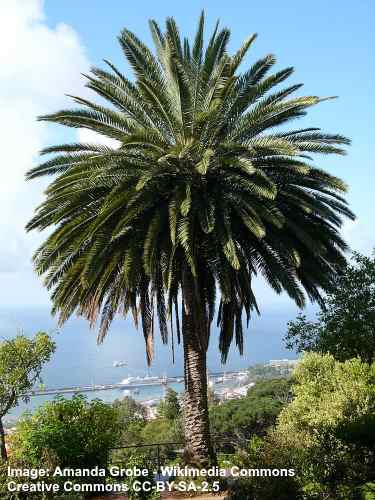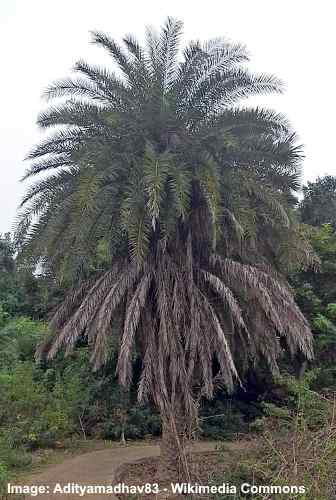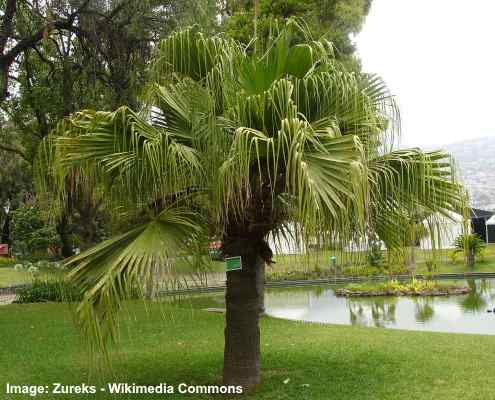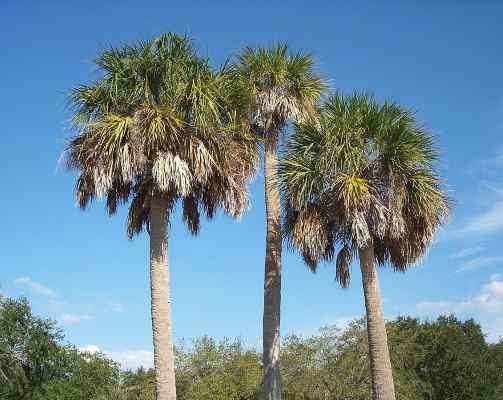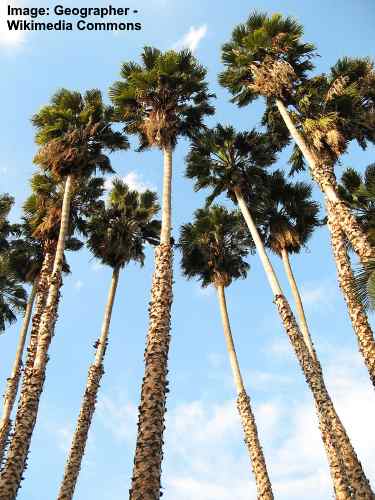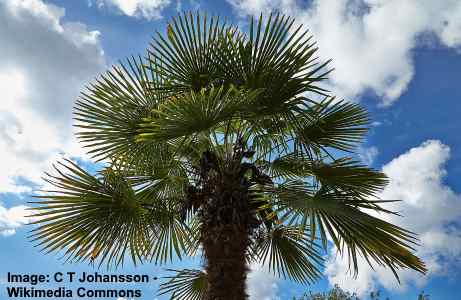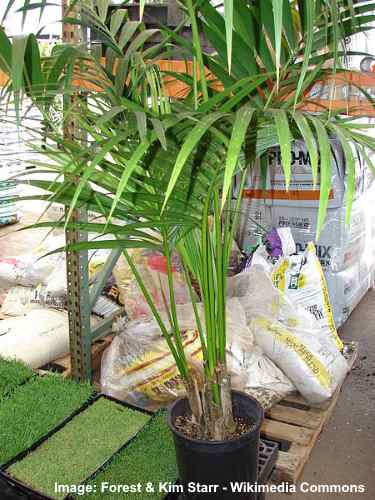74 Types of Palm Trees with Pictures: Identification Guide

Palm trees are synonymous with tropical beaches, warm sunny climates, and beautiful landscaped gardens. Palms are recognized by their fan-shaped or feather-like fronds (leaves) and fiber-covered trunks or stems. Most types of palms, such as date palms and coconut palms, grow in warm climates. However, some species of palms are tolerant of temperate climates and cold temperatures. Some varieties of palm trees can also grow indoors as houseplants.
The most popular varieties of palm trees include the Pygmy Date palm, Pindo Palm tree, Triangle palm plant, and the Mediterranean dwarf palm. Other notable palm trees include the Mazari palm, Dwarf Majesty palm tree, Christmas palm tree, and Bottle palm tree.
Palm trees are evergreen plants belonging to the Arecaceae family of plants. There are over 2,600 species of palm trees that are grouped into over 200 genera. Palm trees are classified by their branchless stems and showy, large evergreen leaves.
Different types of palms also grow to varying heights. For example, types of coconut palms, with their long, wispy leaves, can grow to nearly 100 ft. (30 m) tall. Date palms, with their delicious sweet date fruits, can grow to 75 ft. (22 m).
Some small palm trees are perfect for planting in gardens, as they just reach heights of 6 to 9 ft. (1.8 – 2.7 m). There are also some types of dwarf palm tree plants that grow well indoors in containers.
In this article, you will learn about tall, small, dwarf and indoor varieties of palm trees. You will learn how to identify the different varieties of palm trees and you’ll find their pictures and common names. This will help you choose the perfect palm plant for your garden or for growing indoors.
Palm Tree Facts
Palm trees are grown for their ornamental appearance as well as for palm-derived products. For example, coconuts grow on palm trees and are used for their flesh, fibrous husks, and oil. Date palm trees are common in Mediterranean and Middle Eastern countries. Palm trees are also grown for their oil (palm oil) and their wood to make wicker furniture.
Some species of palm trees are among the tallest trees in the world. Although palm trees don’t grow as tall as Californian sequoia trees, the Wax Palm in Colombia can reach heights of 200 ft. (60 m). These trees are as tall as a 25-story building!
Not all palm trees are actually trees. Some of the more than 2,600 different types of palms are shrub-like evergreen plants and some are climbing palms.
Palm Tree Identification
Identifying species of palm trees is usually done by the distinctive shapes of the palm fronds (leaves) and their trunk. Typically, palm tree leaves are either pinnate (feather-like) or palmate (fan-like).
Another way to identify the type of palm tree is by their trunks. Some of the tallest species of palm trees have long slender single trunks and dwarf varieties usually have short fat palm trunks. Some smaller palm tree species may have clustered trunks with 3 or 4 short trunks growing together. There are also some dwarf palm trees that just have bushy pinnate fronds growing out of the ground and don’t have any trunk at all.
You can also tell the species of palm tree by the appearance of the trunk. Some tall palm trees have smooth, slender trunks. Depending on the species, these types of trees may have a ringed or bumpy appearance and have a grayish-brown color. Some types of palms have trunks covered in fiber or husks that make the trunk look hairy or spiky.
Small Types of Palm Trees (Including Dwarf Palm Trees) – With Pictures
Most people who want to grow palm trees in their yard look for small or miniature types of palm trees. Usually species of miniature or small palm trees are defined as being under 12 ft. (3.6 m) tall, which in terms of palms is quite short. Within the small or dwarf palm tree category there are two types of palm trees: bushy palm trees and small palm trees.
Here are some of the most common types of small, dwarf, and bushy palm trees.
Cat Palm (Chamaedorea Cataractarum)
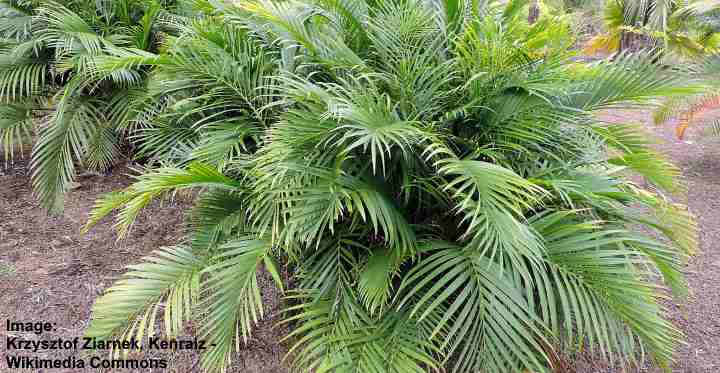
Due to its small size, the cat palm can be grown indoors
The cat palm is a small palm plant with slender pinnate dark green leaves growing on thin stems that extend straight out of the ground. This trunkless palm tree grows 6 ft. (2 m) high outdoors and 3 ft. (1 m) high indoors. In time, the clumping palm forms a dense thicket of shiny slender leaflets.
The identifiable features of a cat palm are the skinny green stems and pinnate leaves, trunkless growth, and flowering stems of yellow ball-like blooms. If the palm is pollinated, small shiny green palm fruits appear that ripen to black ovoid-shaped drupes 0.5” (1.25 cm) long.
The common use of this small palm is as a garden plant in warm climates. However, due to its clumping, bushy habit, it is one of the few palm plants that can be used outdoors as an evergreen hedge plant. In colder climates, cat palms are ideal for growing in pots indoors if there is plenty of sunlight.
Mature Size: 6 ft. (2 m) outdoors, 3 ft. (1 m) indoors
USDA Hardiness Zones: 9 to 11
Sun Exposure: Full to partial shade
Further reading: Cat Palm – Care and Growing Guide.
Pygmy Date Palm (Phoenix roebelenii)
As its common name suggests, the pygmy date palm is a small-sized palm tree. This is a true type of palm in the family Arecaceae and it doesn’t grow taller than 10 ft. (3 m). The small palm tree can be identified by its single stem with long bushy pinnate fronds that measure around 3 ft. (1 m) long.
This palm species is an excellent ornamental flowering tree for subtropical landscaped gardens. The arching-drooping fronds of pygmy date palm are large and showy and almost hide the spiky-looking trunk. These short palm trees also grow well in containers.
Although pygmy palm trees produce dates, the fruit generally isn’t as tasty as dates that grow on larger date palms.
Mature Size: 6 to 10 ft. (1.8 – 3 m)
USDA Hardiness Zones: 9 to 11
Sun: Full sun
Pindo Palm (Butia odorata)
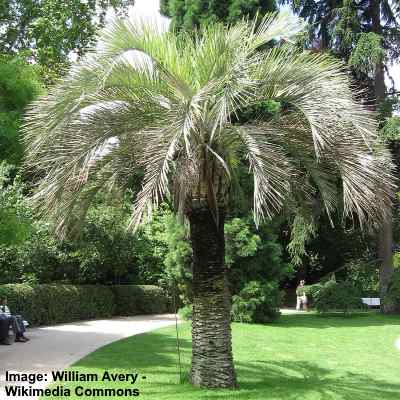
The pindo palm tree is a slow growing, cold-hardy, and small palm tree variety. It’s an excellent palm tree for residential landscapes
Also named the jelly palm, the Pindo palm is a species of cold-hardy palm tree. The palm is known for its arching, blue-gray feather-like fronds that curve to the ground. Although mature jelly palms can reach a height of 15 to 20 ft. (4.5 – 6 m), they are a slow-growing species of palm. This means that they are suitable for gardens where small palm trees are required. Their compact stature makes them great for planting in small gardens, urban landscapes, or containers.
The Pindo palm’s cold hardiness enables it to thrive in temperatures as low as 14°F (-10°C). Due to its exceptional drought tolerance, the Pindo palm is a superb option for planting in arid climates or areas with restricted water access. Ensuring appropriate irrigation during the initial growth stage is essential for fostering healthy development and growth.
These short palm trees thrive in full sun or partial shade and are tolerant of most soil types. The fruits of the palm trees are a light orange to brown color and are used to make jelly – hence the name ‘jelly palm.’ The palm is especially attractive when it flowers with red, yellow, or white blossoms.
Mature Size: 15 to 20 ft. (4.5 – 6 m)
USDA Hardiness Zones: 9 to 11
Sun: Full sun to partial shade
Triangle Palm (Dypsis decaryi)
The triangle palm is the common name for the Dypsis decaryi palm, which is in the small to medium-sized category of palm trees. The triangle palm is identified by its extremely long, pinnate fronds that grow up to 8 ft. (2.5 m) long. One interesting feature about the fronds is that the leaflets point out at 120°, giving the fronds a triangular shape on the cross-section.
Provided the right conditions, the triangle palm can produce magnificent yellow-green blooms all year round. These flowers appear on stalks that can extend beyond 3 ft. (1 m) in length. The leaves of the triangle palm fan out from a single fibrous stem to form a distinct triangle shape, giving the tree its name.
The tree is best suited for planting in subtropical or tropical climates. It is best grown in climates with temperatures ranging from 70 – 85°F (21 – 29°C). The triangle palm is ideal in a landscape as a backyard tree. Consider planting these trees in groups to create a striking effect.
Mature Size: 25 – 30 ft. (7 – 9 m)
USDA Hardiness Zones: 10 to 11
Sun Exposure: Full sun to partial shade
Mediterranean Dwarf Palm (Chamaerops humilis)
Also called the European fan palm, this species of flowering palm is a small-growing tree. The Mediterranean dwarf palm (Chamaerops humilis) has a few clustered trunks that make the palm look more like a shrub than a tree. The bark-covered trunks have a rugged texture and are brown in color. In warm climates, this small palm species grows to between 10 and 20 ft. (2 – 5 m) tall.
The palm fronds of the European fan palm are light green to blue-green in color and grow in a fan shape. The leaflets are between 20” and 30” (50 – 80 cm) wide, and each leaf is up to 5 ft. (1.5 m) long. During the spring season, the palm tree produces blossoms that are golden-yellow in hue.
The Mediterranean dwarf palm is prized for its ornamental value and cold hardiness down to 10°F (−12°C). The palm is drought-tolerant once established, making it great for planting in arid conditions. For optimal growth, plant in well-drained, loamy soils. Its small size allows it to be planted in pots. The elegant palm can give gardens a tropical look even if you live in a temperate climate.
Mature Size: 10 to 20 ft. (2 – 5 m)
USDA Hardiness Zones: 8 to 11
Sun Exposure: Full sun to partial shade
Mazari Palm (Nannorrhops ritchiana)
The Mazari palm resembles more of a shrubby bush than a typical palm tree. It is native to southwestern Asia and features palmate (fan-like) leaves that grow in clusters of stems. The fan-shaped leaves can measure between 1 and 4 ft. (30 – 120 cm) in length.
Apart from the striking look of its leaves, another interesting feature of the palm is its color. The fronds are a silvery-green or silver-blue color, and the long, tapering leaflets give the palm a spiky appearance. The palm produces white blossoms grouped in clusters up to 10 ft. (3 m) long at the stem tips.
Like other types of cold-hardy palm trees, the Mazari palm needs hot summers to grow well. However, this species is also cold-hardy down to 10°F (−12°C). In addition, it is drought-tolerant and prefers well-drained, loamy soil, although it can be grown in other soil types.
Mature Size: 10 – 20 ft. (3 to 6 m)
USDA Hardiness Zones: 6 to 11
Sun Exposure: Full sun
Dwarf Majesty Palm (Ravenea hildebrandtii)
One of the most popular short palm trees for gardens and landscaping is the dwarf majesty palm tree (Ravenea hildebrandtii). This is a single-trunk palm with dark green pinnate leaves. The trunk is slender and is only 3” (7 cm) thick and the palm tree doesn’t grow taller than 8 ft. (2.4 m).
The dwarf majesty palm’s large, wide, arching leaves look majestic as the focal point of any subtropical ornamental garden. The bright green leaves can grow up to 3 ft. (100 cm) long and have up to 100 leaflets growing along the stem. The contrast of the slim trunk and wide crown of foliage can grace any garden. You can also grow this palm in containers.
The dwarf majesty palm is one of the best potted palm trees to grow outdoors.
Christmas Palm Tree (Adonidia merrillii)
If you are looking for a miniature type of palm tree for your garden, then the Christmas palm is an excellent choice. The palm is known for its smooth, light gray trunk with dark rings. Large pinnate palm leaves arch up from the top of the stem to form a beautiful crown of green foliage. The name ‘Christmas palm’ is related to the palm fruit, which matures in December, corresponding with the holiday period.
The Christmas palm is low-maintenance due to its self-cleaning nature. Because it sheds its fronds quite frequently, the tree retains its beautiful appearance throughout its lifespan. This small species of palm tree doesn’t grow taller than 25 ft. (7.6 m); however, some smaller varieties only grow to 15 ft. (4.5 m).
Mature Size: 25 ft. (7.6 m)
USDA Hardiness Zones: 10 to 11
Sun Exposure: Full sun
Bottle Palm Tree (Hyophorbe lagenicaulis)
The bottle palm tree gets its name from the bottle-like shape of the short, fat trunk. This bottle-like trunk helps to differentiate this palm species from the spindle palm, which swells in the middle of the fat trunk.
At the top of the 10 ft. (3 m) high trunk are 3 or 4 huge palm leaves. At maturity, these pinnate leaves can grow to 12 ft. (3.6 m) long and have leaflets that are 2 ft. (0.6 m) long. As the bottle palm grows, its trunk develops a husky exterior, making it look even nicer.
Bottle palm trees do well in warm places like Florida and southern California, where it stays warm all year. They need lots of sunlight for optimal growth. You can also grow them in containers and bring them indoors during winter.
Mature Size: 10 to 12 ft. (3 to 3.6 m)
USDA Hardiness Zones: 10 to 11
Sun Exposure: Full sun
Sago Palm (Cycas revoluta)
Although Cycas revoluta is named the sago palm, it is not a true variety of palm tree. The sago palm belongs to the family Cycadaceae, which may look like a palm but is botanically different. This ‘palm’ is identified by its short trunk and fern-like new leaves.
The sago palm is known for its golden-brown flower head, which is also called a cone. This cone sprouts from the middle of the tree every three to four years. The cone is made up of closely packed scales. The male cone tends to be taller and slimmer than the female cone.
Plant the sago palm in a warm, humid climate in well-drained, moist soil. It requires 6 to 8 hours of sunlight per day for optimal growth. Make sure to water the plant during dry spells. Additionally, when the fronds are a brownish shade, trim them to help maintain the tree’s attractive appearance.
Some landscaping ideas for the sago palm include planting it as a central feature in gardens, patios, and even indoor areas. It also makes a great accent or specimen plant.
Mature Size: 8 – 10 ft. (2.4 – 3 m)
USDA Hardiness Zones: 9 to 11
Sun Exposure: Ample sunlight
Related: Amazing Small or Dwarf Palm Trees.
Red Sealing Wax Palm / Lipstick Palm (Cyrtostachys renda)
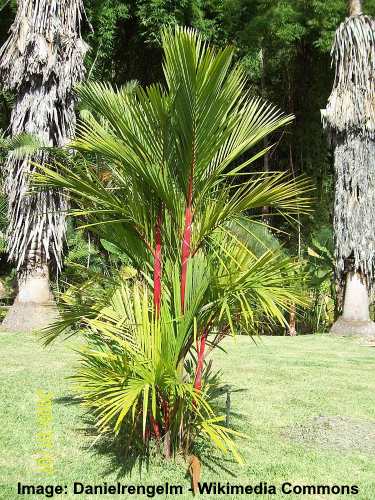
The red sealing wax palm is a small tree with distinctive red leaf stems
The red sealing wax palm has a recognizable bright red crownshaft and leaf sheaths. Also called the red palm, this clumping palm variety can grow 10 – 20 ft. (3 – 6 m) tall. It has long pinnate leaves, greenish flowers, and dark bluish-black fruits.
The red sealing wax palm has eye-catching stems that start out red but gradually turn to a green hue as the plant grows. The palm also showcases small green flower stalks and inedible oval black fruits.
The beautiful red sealing wax palm is suitable for growing in USDA zones 10 and 11. However, if you want to enjoy the beauty of this red palm, you can also grow it in pots indoors.
Mature Size: 10 to 20 ft. (3 – 6 m)
USDA Hardiness Zones: 10 and 11
Sun Exposure: Full sun
Arikury Palm (Syagrus schizophylla)
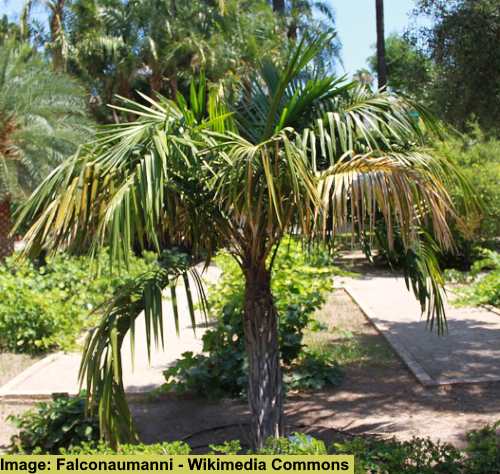
The arikury palm is a dwarf tree suitable for small gardens
The arikury palm is a small ornamental palm tree with arching, olive to dark-green fronds forming a spreading crown. This popular accent palm is perfect for compact gardens because it doesn’t grow taller than 6 ft. (1.8 m). The evergreen palmate leaves measure 4 to 6 ft. (1.2 – 1.8 m).
Suitable for subtropical landscapes in USDA zones 9 to 11, the arikury palm is recognized by its arching, flat leaflets growing on very long jagged petioles. Additionally, the palm blooms with pale yellow flowers on thick arching, pendulous stems measuring up to 3 ft. (1 m) long.
An identifying characteristic of the arikury palm is its toothed leaf stems — a unique feature that palm species of the Syagrus genus rarely have.
Mature Size: Up to 6 ft. (1.8 m)
USDA Hardiness Zones: 9 to 11
Sun Exposure: Full sun to partial shade
Florida Cherry Palm (Pseudophoenix sargentii)
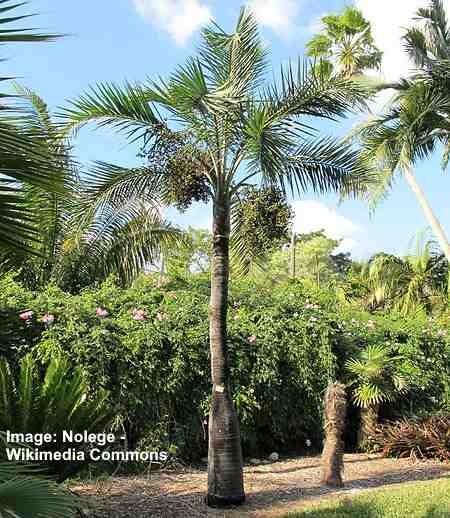
The Florida cherry palm is medium-sized tree which is slow growing and cold sensitive
The native Florida cherry palm tree is a medium-sized palm, identified by its ringed, smooth, solitary stem, silver-green branches, leaflets, and clusters of greenish-yellow flowers. The palm’s greenish-blue or silvery leaflets grow on arching stems with 8 to 12 fronds forming an attractive crown at the end of a short, stout crownshaft.
Also called the buccaneer palm tree, the Florida cherry palm grows 10 to 25 ft. (3 – 7.6 m) tall with a canopy 8 to 12 ft. (2.4 – 3.6 m) wide. However, growing it in a container limits its size, making the small palm suitable for growing in a planter. Also because it is slow-growing and relatively small — the height of some specimens maxes out at 10 – 12 ft. (3 – 3.6 m).
Thriving in full sun, the Florida cherry palm tree is suitable for warm tropical and semi-tropical coastal landscapes in USDA zones 10 and 11. Its tolerance for salty air and sandy soils makes this elegant palm tree suitable for growing in harsh coastal regions. You can also grow this tree in a container and move it indoors during winter.
Mature Size: 10 to 25 ft. (3 – 7.6 m)
USDA Hardiness Zones: 10 to 11
Sun Exposure: Full sun
Sand Palm (Allagoptera Arenaria)
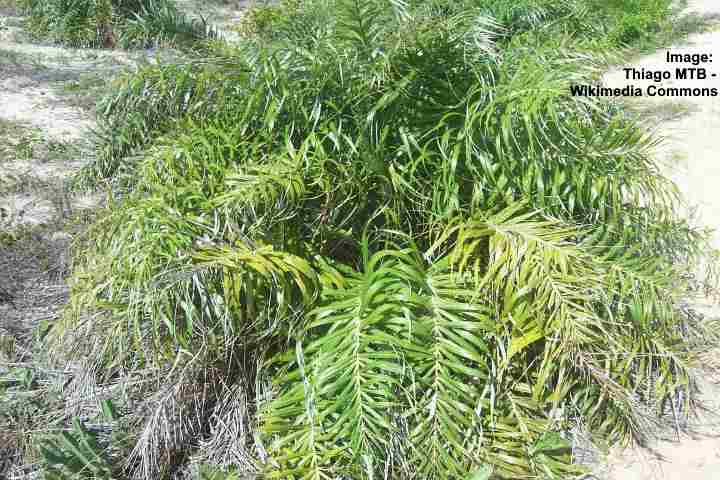
The sand palm is a short tree with leaves that emerge out of the ground from a trunk that is usually invisible
If yard space is limited, the sand palm is a type of small desert plant that is perfect for small yards. The maximum height of these sun-loving palms is about 6 ft. (1.8 m). The large feather-like leaves seem to grow straight out of the ground or container. These tropical leaves grow upward and then arch over.
These palms are native to coastal regions. However, because they tolerate poor soil, drought, and heat, you can plant them in your desert garden.
Dwarf Sugar Palm (Arenga engleri)
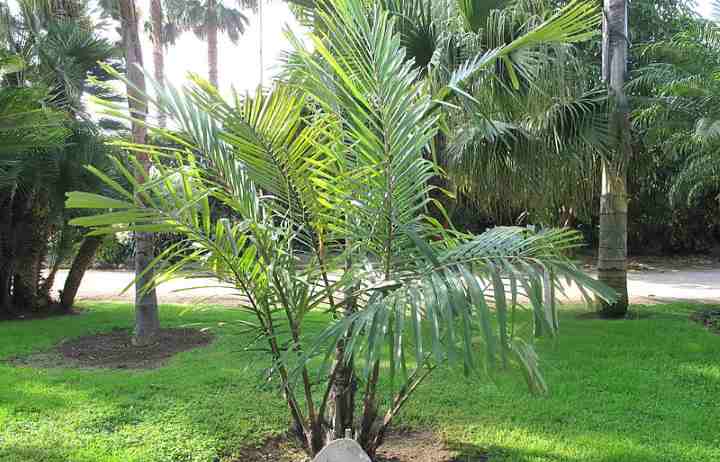
The dwarf sugar palm adds a decorative touch to a small front yard or backyard
The dwarf sugar palm has a clumping, shrub-like growth pattern, which gives it a bushy appearance. Renowned for its vibrant green pinnate foliage that emerges directly from the ground, it serves as an excellent choice for landscaping.
The dwarf sugar palm thrives in mild to warm climates. Although it can tolerate temperatures as low as 25°F (-4°C), it’s best to shelter the tree from frost. It grows best in well-drained, moist soil, ideally with a slightly acidic to neutral pH level.
Plant a dwarf sugar palm as a specimen tree in a tropical garden. Or, you can plant the low palm bushes together to create a tropical privacy screen. It also serves the purpose of establishing an impressive focal point in the garden without dominating the space. Its compact size enables successful growth in diverse garden environments, such as courtyards, patios, and even containers.
Mature Size: 6 – 8 ft. (1.8 m – 2.4 m)
USDA Hardiness Zones: 10b-11
Sun Exposure: Full sun
Other Types of Palm Trees (With Pictures and Names)
Depending on your climate and the type of garden you have, there are many species of tall palm trees that look majestic in subtropical and tropical gardens.
Coconut Palm (Cocos nucifera)

The coconut palm tree grows up to 100 ft. (30 m) tall but there are dwarf varieties to suit smaller spaces
The coconut palm tree is one of the most easily recognizable types of palms. This tall palm tree grows up to 100 ft. (30 m) tall with a grayish-brown, slightly curved smooth trunk and recognizable sprawling, drooping palm fronds that measure 15 – 20 ft. (4.5 – 6 m) long.
Coconut palms are also known for their tropical fruits, often described as the ‘taste of paradise.’ The coconut fruit is initially large and green or yellow when immature. As the fruit matures, it becomes the recognizable brown coconut seed, covered in a hairy fiber and located inside a thick husk. The edible portion of the coconut is the white meat found within the wood-like shell.”
A coconut palm tree can produce up to 75 fruits per year. The large, round fruits grow in bunches, close to the central stem and amongst the leaf stems.
Coconut palm trees typically grow in coastal areas where they thrive in sandy, salty soils. In southern states and tropical countries, you will often see coconut palms growing along beaches, streets, and parks.
There are many dwarf coconut palm tree varieties if you don’t have space for a tall tropical palm in your yard. An example of a dwarf coconut landscaping palms not growing taller than 5 ft. (1.5 m) is the ‘Malayan Dwarf.’
Although you can grow coconut palms indoors, they are challenging to grow successfully. Usually, areca palms are easier to grow indoors if you want an evergreen leafy tropical houseplant plant.
Mature Size: Up to 100 ft. (30 m)
USDA Hardiness Zones: 10 to 12
Sun Exposure: Full sun
Date Palm Tree (Phoenix dactylifera)
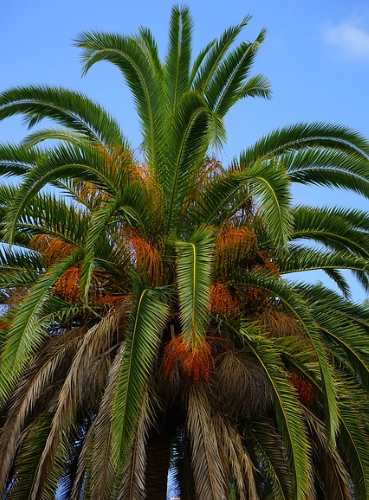
Date palm trees are very tall and produce delicious fruit
The date palm tree is one of the easiest palm trees to identify due to its abundant clusters of delicious dates. In addition, the beautiful palms have an identifiable long rough trunk, a crown of arching feathery fronds up to 20 ft. (6 m) long, and clusters of brown, red, or yellow fruits.
Date palm trees are tall and grow 70 to 75 ft. (21 – 23 m) high. The spiny leaf stems can measure between 13 and 20 ft. (4 – 6 m) long. The vast leaves have up to 150 leaflets that are 12” (30 cm) long. In total, the date palm’s impressive light green crown can be between 20 and 30 ft. (6 – 10 m) wide.
Date palm trees are best known for their delicious sweet sticky fruits, which are a type of drupe. The edible oval fruits are typically dark brown with wrinkled skin. However, other varieties of date palms can produce deep red, black, yellow, or golden yellow bunches of dates.
Mature Size: 70 to 75 ft. (21 – 23 m)
USDA Hardiness Zones: 8 to 12
Sun Exposure: Full sun
California Fan Palm (Washingtonia filifera)
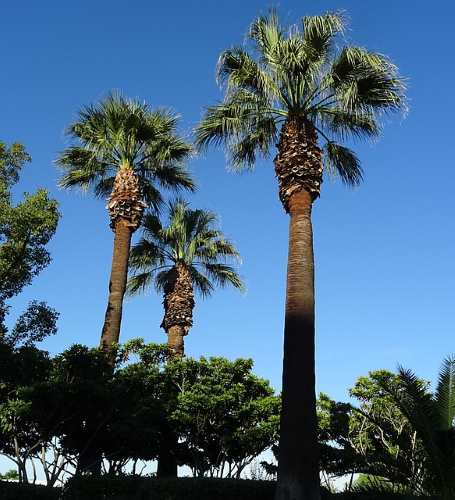
The ornamental California fan palm is identified by its fan shaped fronds
The California fan palm is a medium-sized ornamental palm tree with long, fan-shaped fronds with fibrous threads and a sturdy columnar trunk. The identifying feature of the California fan palm is its spectacular leaves made up of waxy green blades that spread out in a fan shape.
This native California palm tree grows between 40 and 60 ft. (12 – 18 m) tall.
Other identifying features of the California fan palm are its grayish and tan trunk that stands erect. In addition, it’s easy to recognize California palms due to the skirt-like shape of dead fronds near the top of the tree. After the gray-green leaves die, they droop down and turn brown.
This easily identifiable palm tree also goes by the name petticoat palm due to the palm’s distinctive crown. The recognizable fan shape of the leaves also gives it the name desert fan palm.
Its botanical name Washingtonia filifera refers to the thread-like strands on the green palmate leaves.
Mature Size: 40 to 60 ft. (12 – 18 m)
USDA Hardiness Zones: 8 to 11
Sun Exposure: Full sun
Chilean Wine Palm (Jubaea chilensis)
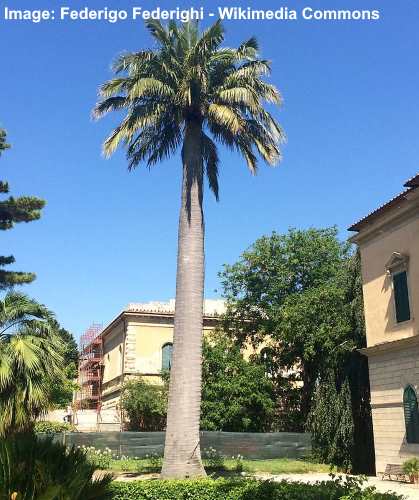
The slow growing Chilean wine palm has a smooth gray trunk
The Chilean wine palm is a tall palm tree, identified by its thick, columnar, smooth gray trunk, long arching feather-like green fronds, and stunning crown. The identifiable feature of this hardy palm is its broad, straight trunk measuring up to 3 ft. (1 m) in diameter, which is swollen at the base.
Considered one of the most impressive palm trees in the world, the Chilean wine palm grows 60 to 80 ft. (18 – 24 m) tall. The dense, upward growing crown consists of palmate fronds measuring 15 ft. (4.5 m) long. Unlike many palms with fibrous trunks, this palm species has a smooth gray trunk. Additionally, small purple and yellow flowers bloom in summer, adding to the palm’s grace and beauty.
When the palm is relatively immature, it has a stumpy appearance with an explosion of large arching fronds. The palm’s slow growth means that it takes many years to reach its mature height.
Although native to Chile, this single-trunked palm tree is cold hardy, and can thrive in temperate climates. You can find Chilean wine palms growing in Ireland, Northern and Southern California, and South Africa. The palm also goes by the common names honey palm, palm honey tree, and Chilean coquito palm.
Mature Size: 60 to 80 ft. (18 – 24 m)
USDA Hardiness Zones: 8 to 11
Sun Exposure: Full sun
Florida Royal Palm (Roystonea regia)
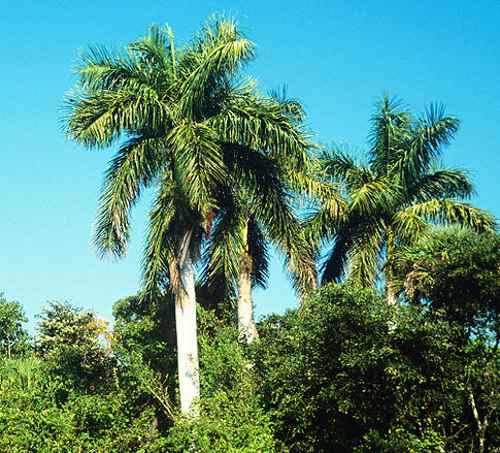
The Florida royal palm is identified by a smooth erect pale trunk and bushy crown
The Florida royal palm is a majestic palm tree with a smooth gray-white trunk, crown of dark green fronds, and rounded red fruits. Identifying features of this palm tree are its smooth green crownshaft, bulging stem base, and erect trunk growing 65 to 100 ft. (20 – 30 m) tall.
The palm’s distinctive crown comprises 15 arching fronds measuring 13 ft. (4 m) long. Small pinkish-white flowers appear in late spring. After pollination, the palm tree produces fruit—round drupes 0.6” (1.5 cm) long and 0.4” (1 cm) wide. The slender, smooth trunk and bushy crown invoke the thought of tropical landscapes
The Florida royal palm is relatively tolerant of salty air, making it perfect for planting in coastal landscapes. Once established, it is moderately drought-tolerant. This smooth, tall Florida palm has the unusual growth habit of shedding its old fronds. You will find this ornamental street palm growing in Florida, Texas, Southern California, and Hawaii.
Mature Size: 65 to 100 ft. (20 – 30 m)
USDA Hardiness Zones: 10 to 11
Sun Exposure: Full sun to partial shade
Açaí Palm (Euterpe oleracea)
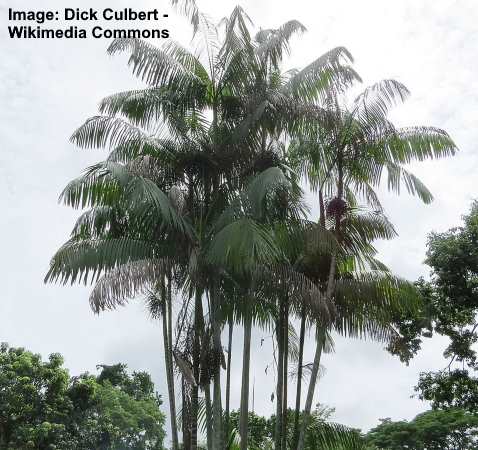
The açaí palm has multiple skinny tall trunks
The acai palm tree is a skinny palm tree with multiple tall, clustering stems. The acai palm is identified by its bunches of berry fruits 1” (2.5 cm) in diameter and long, pinnate leaves growing up to 10 ft. (3 m) long.
Acai palms are native to South America, where they grow in swamps and floodplains. The most valuable feature of the acai palm is its berries. Acai berries are small black drupes that grow abundantly on drooping stems. There can be between 500 and 900 fruits in a single bunch.
Mature Size: Around 26 to 98 ft. (8 – 30 m)
USDA Hardiness Zones: 10 to 12
Sun Exposure: Full sun to partial shade
Peach Palm (Bactris gasipaes)
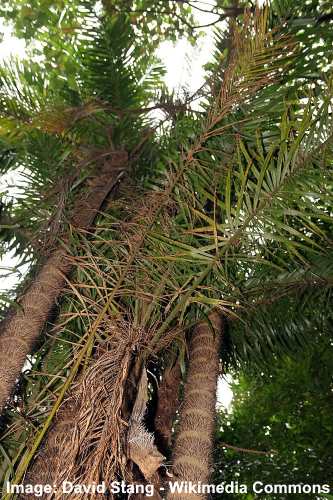
The peach palm has a unique circular spines on its trunk
The peach palm is a fruit-producing palm tree that has clusters of red palm fruits. Peach palms with their red fruits grow around 66 ft. (20 m) tall. The multi-stemmed thorny tree has spiky crowns of pinnate fronds that are 10 ft. (3 m) long.
Peach palms are a type of tall clumping palm tree with edible fruit. The pulpy palm fruits are typically red. However, other varieties of peach palms can have yellow or orange peach-like fruits.
An identifying feature of a peach palm is its spiny trunk. The slender trunk measures (10 – 25 cm) in diameter. However, up close, pictures of the trunk reveal that the palm tree has thorns in circular bands around the brownish-gray trunk.
Mature Size: 19.6 to 79 ft. (6 – 24 m)
USDA Hardiness Zones: 11 to 12
Sun Exposure: Full sun
Oil Palm (Elaeis guineensis)
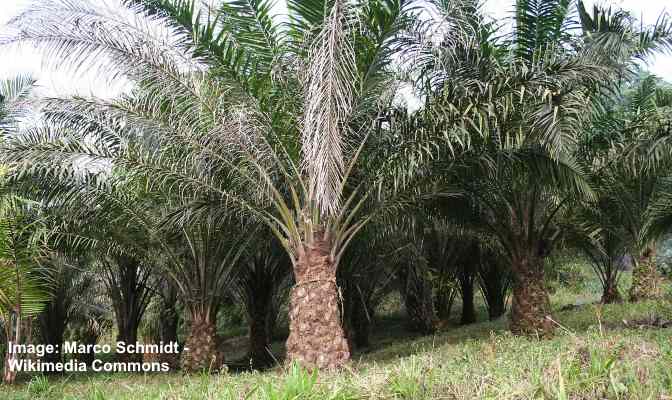
Oil palm fruits are commonly used in oil production
The oil palm is famous for the oil that is pressed from its fruit. Oil palm trees grow over 66 ft. (20 m) tall and have massive pinnate fronds measuring 10 to 16 ft. (3 – 5 m) long. The valuable fruit from the tree grows like red palm berries and is about the size of a plum. The tree also produces dense clusters of pale-yellow flowers.
The oil palm is a single-stemmed variety of palm tree. The attractive palm leaves grow in an upward, arching habit, giving the decorative tree a vase-shaped appearance. The palm’s recognizable characteristic is the large bunches of 200 to 300 red palm fruits growing close to the trunk.
Mature Size: Up to 66 ft. (20 m)
USDA Hardiness Zones: 10 to 12
Sun Exposure: Full sun
Foxtail Palm (Wodyetia bifurcata)
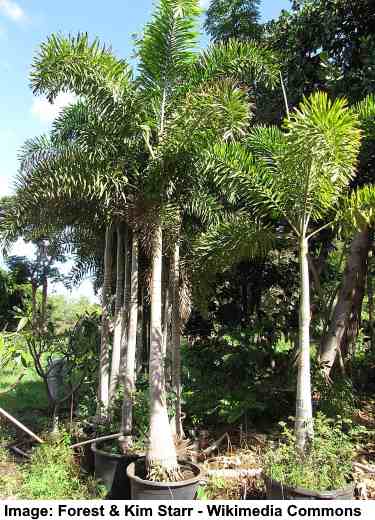
The foxtail palm is a medium sized decorative tree suitable to grow in Southern Florida
The foxtail palm tree is an impressive medium-sized palm tree. It is known for its massive, arching fronds measuring 6.5 – 10 ft. (2 – 3 m) long. It has a light gray to white trunk with distinctive rings. The ornamental palm is identified by its plume-like foliage that looks like a bushy fox’s tail—hence the name foxtail palm. It is often grown in south Florida due to its ideal climate.
Another identifying feature of the foxtail palm is its large, egg-shaped orange palm fruit. The oval fruits emerge olive green, ripen to an orange or deep red color, and measure 2” (5 cm) long. It also produces creamy white flowers that grow on long stalks at the base of the crownshaft.
The foxtail palm is self-cleaning, so little maintenance is needed when growing this palm. It is tolerant of drought and grows best in well-drained soil.
Mature Size: 30 ft. (9 m)
USDA Hardiness Zones: 10 to 11
Sun Exposure: Full to partial sun
Guadalupe Palm (Brahea edulis)
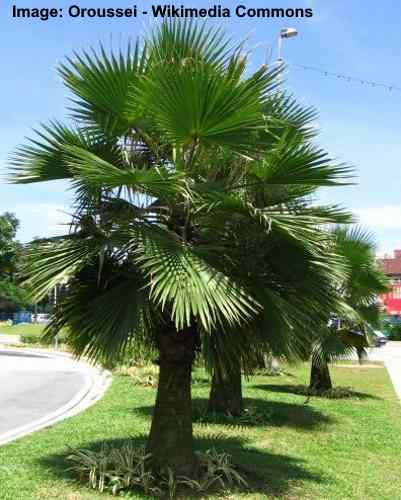
The small and slow growing Guadalupe palm is a popular landscaping tree
The Guadalupe palm tree is a small palm plant with fan-shaped leaves growing on the stems, a rough, brown fibrous solitary trunk, and sweet black palm fruits. The palm also produces fragrant, creamy yellow blooms that grow amongst the foliage. Guadalupe palms grow 15 to 40 ft. (4.5 – 12 m) tall and are slow-growing.
The most distinctive feature of the Guadalupe palm is the stiff leaflets growing in the shape of a fan at the ends of long smooth stems. In the landscape, these palm trees make a dramatic statement due to the spiky appearance of the dense crown. As a result, the ornamental palm is a popular landscaping palm tree in California.
Guadalupe palms are cold-hardy down to around 20°F (-6.6°C). Additionally, they are tolerant of drought, salt, and heat, meaning they can be planted in arid or coastal climates.
Mature Size: 15 to 40 ft. (4.5 – 12 m)
USDA Hardiness Zones: 9 to 11
Sun Exposure: Full sun
Bismarck Palm (Bismarckia nobilis)
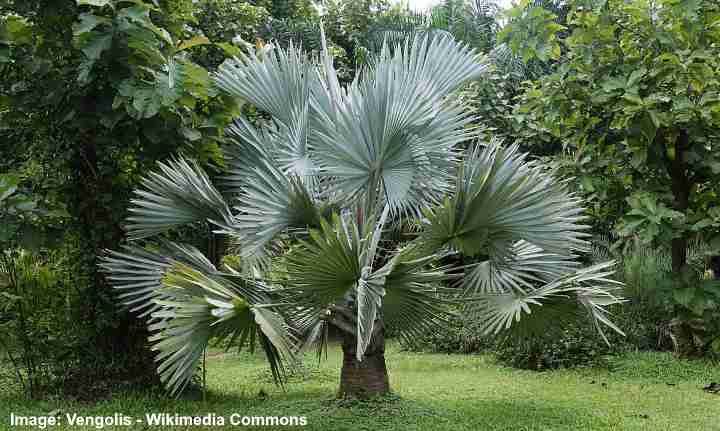
The small Bismarck palm tree has beautiful silvery gray foliage and is cold sensitive
The Bismarck palm is an easily identifiable palm due to its vast fronds of steely-blue or silvery gray spiky leaflets. The fan-shaped palm leaves grow in all directions, creating a spectacular pale green spherical crown that is 20 ft. (6 m) tall and 24 ft. (7.5 m) wide. Its stout, short trunk adds to the palm’s visual appeal.
The Bismarck palm’s eye-catching silvery-blue leaves look like a round spiked fan and can grow over 10 ft. (3 m) wide. This slow-growing palm tree eventually reaches around 40 ft. (12 m) tall in gardens and parks.
The Bismarck palm produces brown flowers that grow on arching stems. These flowers are then followed by small, brown egg-shaped fruits. These chocolate-brown rounded drupes grow in bunches like grapes dangling from this stout palm tree. Individual fruits measure 1.5” (3.8 cm) long and grow densely on 4 ft. (1.2 m) long stems.
Some landscaping ideas for the Bismarck palm include planting the tree as an individual focal point, specimen tree, or lawn tree. It is also highly drought-tolerant, meaning that it can be planted in dry, arid environments. It is a popular small landscaping palm in Florida, Southern California, Texas, and Arizona. With its beautifully colored fronds, it is sure to add beauty to any garden.
Mature Size: 40 ft. (12 m)
USDA Hardiness Zones: 10 and 11
Sun Exposure: Full sun to partial shade
Cayman Thatch Palm (Coccothrinax proctorii)
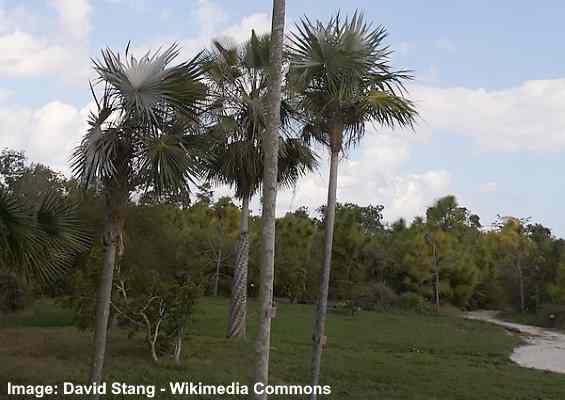
Proctor’s silver palm has a skinny trunk and fan shaped leaves and is slow growing tree
The Cayman thatch palm is a medium-sized palm tree with a single skinny trunk and dark green fronds, creating a symmetrical crown. This slow-growing tropical palm tree grows between 10 and 20 ft. (3 – 6 m) high. As the majestic palm tree matures, the trunk gradually becomes smooth and gray.
Cayman thatch palms are native to islands in Central America. The palm tree has characteristic fan-shaped leaves that are typical of palms growing in tropical or subtropical climates. In addition, Cayman thatch palm leaves form an open rounded or triangular crown.
The Cayman thatch palm is slow-growing, meaning you can use it as an attractive landscaping plant or specimen tree. Being salt-tolerant, they are perfect for planting in coastal landscapes. The palm is popular in Florida, where it is often grown in smaller landscapes.
Mature Size: 10 to 20 ft. (3 – 6 m)
USDA Hardiness Zones: 9b to 11
Sun Exposure: Full sun or light shade
MacArthur Palm (Ptychosperma macarthurii)
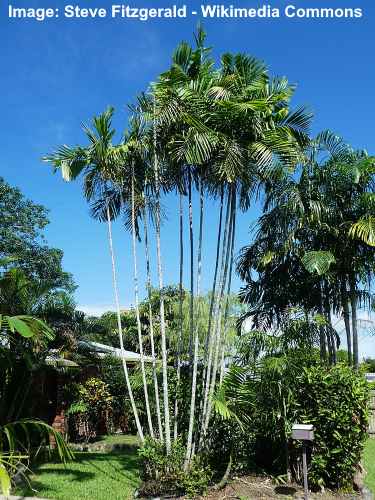
The MacArthur palm is identified by multiple tall skinny trunks
The MacArthur palm tree is a tall skinny palm tree with multiple stems that grow up to 33 ft. (10 m) tall. The MacArthur palm is easy to identify in the landscape due to its clumping habit, slender, smooth trunks, green crownshaft, and rounded spiky crown.
MacArthur palm leaves grow up to 10 ft. (3 m) long and have between 30 and 80 leaflets measuring 22” (56 cm) on each leaf stem. The dense palm crown can have between 3 and 13 fronds, giving the slender palm tree the characteristic look of tropical landscapes.
In the landscape, MacArthur palms grow as multi-stemmed palm trees, making them easily identifiable. Other identifying traits of the palm are a whitish trunk with dark rings, clusters of yellowish-green flowers, and bunches of small bright red fruit. Drought- and heat-tolerant, they are perfect for planting in arid environments.
Mature Size: Up to 33 ft. (10 m)
USDA Hardiness Zones: 10 to 11
Sun Exposure: Full sun to partial shade
Canary Island Date Palm Tree (Phoenix canariensis)
The Canary Island date palm is a tall, elegant palm tree that can be identified by its large pinnate leaves, which resemble an explosion of foliage. This low-maintenance palm tree has a thick, scaly trunk, yellow edible dates, and branching clusters of pale-yellow flowers.
Depending on the climate, Canary Island date palms can grow to heights ranging from 33 to 66 ft. (10 – 20 m) tall. The dark-green leaves measure 13 – 20 ft. (4 – 6 m) in length and form an elegant crown. Its trunk can also reach a diameter of around 3 ft. (1 m).
The Canary Island date palm is cold-hardy down to 18°F (-8°C). Once established, it is tolerant of drought and salt spray, making it ideal for growing in arid or coastal landscapes. Some landscaping ideas include planting it as a focal point in larger areas such as parks or spacious yards, where its stunning presence can truly shine.
Mature Size: 33 to 66 ft. (10 – 20 m)
USDA Hardiness Zones: 9 to 11
Sun Exposure: Full sun
Sylvester Palm Tree (Phoenix sylvestris)
The Sylvester palm tree, related to the Canary palm tree, is a date-producing palm native to India, Pakistan, and Nepal. Some species of the Sylvester palm can be as short as 13 ft. (4 m), while others can grow up to 50 ft. (15 m). Large, blue-green, arching leaves grace the top of this single long stem. Additionally, the tree is known for its pineapple-like scales on its trunk and yellowish-white flower clusters.
Sylvester palms are tolerant of drought and moderately tolerant of salt. They are also cold-hardy down to 15°F (-9.4°C). These palms are often grown in Florida, despite not being native to the state. They are often grown for their orange-yellow dates which are used in the production of jelly and wine.
The sylvester palm is low-maintenance, requiring only the occasional pruning of some fronds to maintain its attractive appearance. Make sure to plant this tree in sandy, well-draining soil in full sun. The tree serves as an excellent accent or focal point in medium-sized gardens.
Mature Size: 13 to 50 ft. (4 – 15 m)
USDA Hardiness Zones: 9 to 11
Sun Exposure: Full sun
Chinese Fan Palm (Livistona chinensis)
Native to Asia and the Far East, the Chinese fan palm (Livistona chinensis) is a single-stemmed palm with bright green, ornate drooping leaves. The palm gets its name from the fan-shaped (palmate) leaves that arch out from the top of the stems. The tree has a spread of up to 12 ft. (4 m).
Some identifying features of the Chinese fan palm are its thick, smooth, gray-brown trunk, blue-black round fruits, and yellow-green flowers that grow on huge stalks. It is also drought- and salt-tolerant, making it great for planting in coastal or dry landscapes.
Mature Size: 10 to 30 ft. (3 – 9 m)
USDA Hardiness Zones: 9 to 11
Sun Exposure: Full sun
Palmetto Palm Tree (Sabal palmetto)
Palmetto palms are a species of tall-growing, elegant palm trees in the genus Sabal, and subfamily Coryphoideae. Sabal palmettos are identified by their striking spiky-looking leaves that grow in a fan shape. Other identifying features include brown, dead fronds hanging from the crown base, white flowers, and purple-black fruits. The straight thick trunks of these tall palm trees stretch up to 65 ft. tall (20 m).
If the palmetto palm reminds you of beaches in South Carolina and Florida, that is because the palm is the official tree of those states. It is even found on the state flag of South Carolina. The palmetto palm is native to Florida and it’s one of the most common types of palm trees in the state.
The cabbage palm is flood- and salt-tolerant. It thrives in poorly drained soil, making it an excellent palm tree for planting in wet environments. Once established, it is also drought-tolerant. Although the tree is low-maintenance, it is recommended to prune the brown or dead fronds to maintain its attractive appearance. Additionally, it can survive winter temperatures as low as 9°F (-12°C).
Mature Size: Up to 65 ft. (20 m)
USDA Hardiness Zones: 8 to 11
Sun Exposure: Full sun
Mexican Palm tree (Washingtonia robusta)
Also called the ‘Mexican washingtonia’, this species of palm tree has a long narrow trunk and bushy-like leafy foliage at the top. The dead leaves of the palm form a dense skirt around the trunk. The tree features palmate fanned leaves measuring up to 3.3 ft. (1 m) long sit gracefully on top of 82 ft. (25 m) tall stems.
The Mexican palm produces drooping sprays of small, fragrant white flowers. These flowers are followed by clusters of round, blue-black, edible palm fruit. Although it should be noted that the dates aren’t as tasty as dates from other types of palms.
The Mexican palm is drought-tolerant and low-maintenance, meaning it can be planted in arid environments without much trouble. Additionally, the palm’s tolerance of salt spray and winds makes it perfect for planting near the coast.
Mature Size: Up to 82 ft. (25 m)
USDA Hardiness Zones: 9 to 11
Sun Exposure: Full sun
Windmill Palm Tree (Trachycarpus fortunei)
The windmill palm tree can grow as tall as 66 feet (20 m). This evergreen palm tree can be identified by its slender trunks, fan-shaped leaves, and rough appearance. Other identifying features of the windmill palm include stunning clusters of small, yellow flowers and blue-black fruits.
The windmill palm is cold-hardy, capable of tolerating occasional temperatures as low as 5°F (-15°C). For optimal growth, plant the windmill palm in fertile, moist, well-drained soil. It is drought-tolerant. Make sure to protect this tree from cold winds and frost.
Mature Size: Up to 66 ft. (20 m)
USDA Hardiness Zones: 7 to 11
Sun Exposure: Full sun to partial shade
King Palm / Bangalow palm (Archontophoenix cunninghamiana)
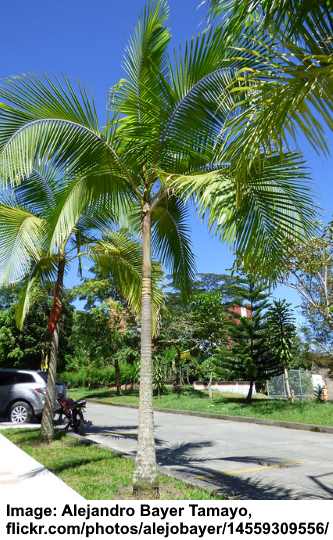
The king palm is a tall tree with a slender trunk
The king palm tree is a beautiful palm identified by its attractive crown of bright green fronds, pink flowers, and clusters of bright red dates. The trunk is brownish-gray, straight, slender, and wider at the base. This palm thrives in tropical and subtropical climates. The palm tree has an attractive crownshaft consisting of 15 to 20 large arching fronds.
Also called the Bangalow palm or Illawara palm, this tall palm tree can grow over 65 ft. (20 m) tall. Its huge evergreen fronds measure around 15 ft. (4.5 m) long, consisting of up to 150 leaflets that are 6” to 12” (15 – 30 cm) long. Like most palms, rings around the erect, slender trunk reach up to the smooth greenish-brown crownshaft.
For optimal growth, plant the king palm in sandy, well-drained soil in full sun. The king palm is self-cleaning, so no pruning is necessary.
Mature Size: Up to 65 ft. (20 m)
USDA Hardiness Zones: 10 to 11
Sun Exposure: Full sun to partial shade
Red Latan Palm Tree (Latania lontaroides)
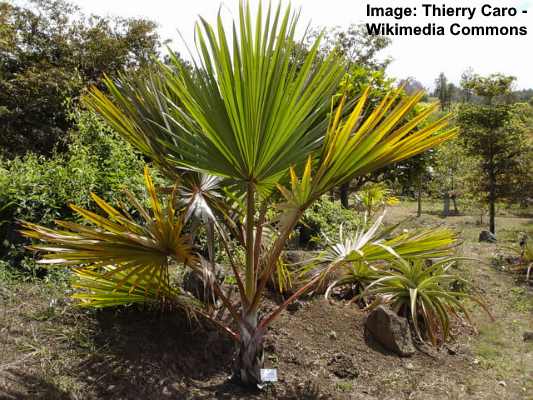
The red latan is a medium sized slow growing palm tree
The red latan is a medium-sized palm tree with a distinctive spiky appearance. In addition, this tropical palm tree has characteristic fan-like fronds consisting of stiff, spiky leaflets. The attractive palm tree fronds measure 8 ft. (2.4 m) wide and create a beautiful, rounded crown with a 20 ft. (6 m) spread.
An identifying feature of red latan palm trees is the reddish leaves and stems growing on immature trees. As the slow-growing palm tree matures, it reaches a height of 30 to 40 ft. (9 – 12 m). Mature red latan palms have green foliage with a white, silvery appearance.
Other features that help identify the red latan palm are clusters of yellow spring flowers, brownish-green fleshy drupes measuring 2” to 3” (5 – 7.5 cm) long, and a slender grayish trunk with light rings around it.
The red latan is highly tolerant of drought and salt spray, making it perfect for planting near the coast.
Mature Size: 30 to 40 ft. (9 – 12 m)
USDA Hardiness Zones: 10 to 11
Sun Exposure: Full sun
Fishtail Palm (Caryota mitis)
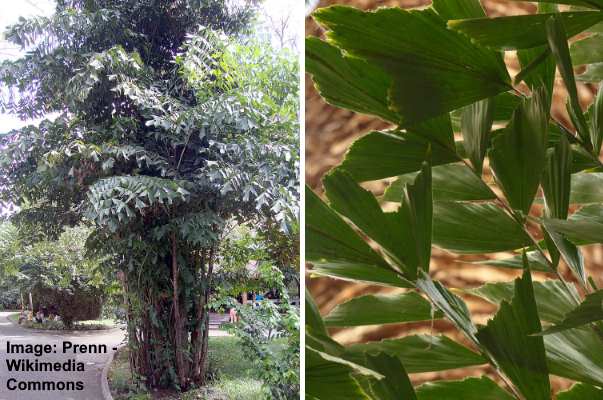
The fishtail palm is a multi-stemmed tree with distinctive leaves
The fishtail palm is an attractive, multi-stemmed palm tree with light, glossy green leaves resembling a jagged fish’s tail. Masses of small deltoid leaflets grow on long stems, forming thick layers of ruffled fronds. The clumping palm tree grows around 40 ft. (12 m) tall and 10 ft. (3 m) wide.
Apart from its easily identifiable bipinnate fishtail leaves, the fishtail palm blooms with attractive creamy-white flowers, followed by dark red fruits. Unfortunately, the dark drupes on Fishtail palm trees are poisonous and should never be eaten.
The long shiny palm fronds can grow up to 10 ft. (3 m) long. The ruffled fishtail compound leaves grow on long stems that give the palm tree a weeping appearance.
The fishtail palm is low-maintenance, with only the occasional pruning of dead leaves needed to maintain its attractive appearance.
Mature Size: 40 ft. (12 m) tall and 10 ft. (3 m) wide
USDA Hardiness Zones: 8 to 11
Sun Exposure: Full sun to partial shade
Montgomery Palm (Veitchia arecina)
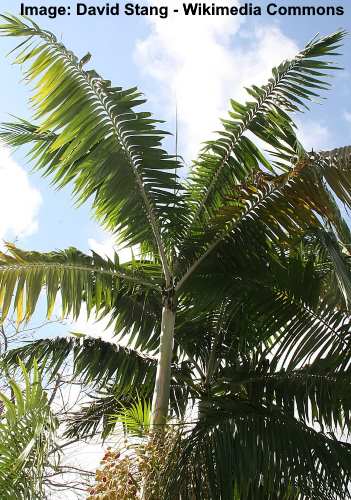
The Montgomery palm is an attractive tall tree with a slim trunk and beautiful crown
The Montgomery palm is a tall solitary palm tree, identified by arching fronds and drooping leaflets, greenish-white flower clusters, and oval red fruits. Montgomery palms have the characteristic appearance of tropical climates. Straight, slender trunks with a graceful spreading crown at the end of a smooth pale green crownshaft help identify this palm.
Montgomery palms reach heights of 80 ft. (24 m) tall. The stiff, arching fronds grow up to 10 ft. (3 m) long and contain lanceolate drooping leaflets. In spring, Montgomery palms are identified by clusters of greenish-white flowers measuring 3 ft. (1 m) long growing at the base of the crownshaft. After blooming, bright yellow or red fruits appear on pendulous stems.
Once established, the Montgomery palm is drought-tolerant and capable of growing in temperatures down to 30°F (-1°C). Plant this tree in a sunny spot in moist, well-drained soil for optimal growth. These trees are often grown in southwest Florida due to its ideal humid, tropical climate.
Mature Size: 80 ft. (24 m)
USDA Hardiness Zones: 10 to 11
Sun Exposure: Full to partial sun
Puerto Rican Thatch Palm (Coccothrinax alta)
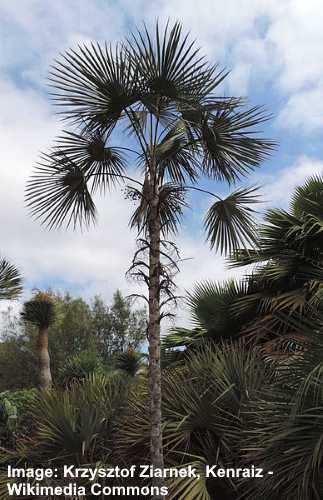
The Puerto Rican thatch palm is easily identified due to its tall trunk and sparse crown
The Puerto Rican thatch palm tree is an exceptionally tall palm with a slender single bare trunk. The identifying feature of the thatch palm is its palmate leaves which grow in a fan shape, creating an open crown. The palm fronds measure 5 ft. (1.5 m) across.
After blooming, the yellow flowers on the Puerto Rican thatch palm give way to purplish-black fruits 0.23” to 0.47” (6 – 12 mm) in diameter. The palm is easy to spot in a tropical landscape due to its erect stem growing around 50 ft. (15 m) tall and its sparse crown.
The Puerto Rican thatch palm’s tolerance of salty winds makes it ideal for beachside planting.
Mature Size: 50 ft. (15 m)
USDA Hardiness Zones: 10 to 11
Sun Exposure: Full sun
Everglades Palm (Acoelorrhaphe wrightii)
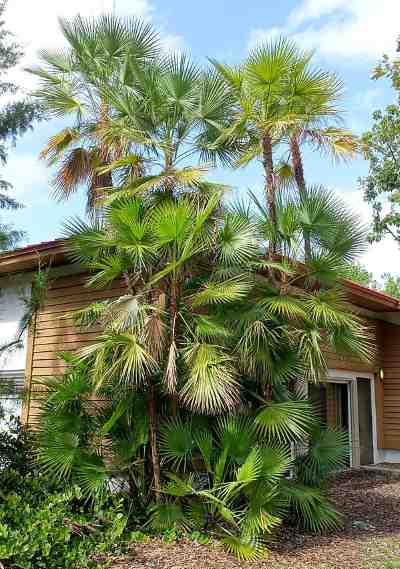
The everglades palm is a small to medium sized tree native to Florida
The everglades palm is a small palm with substantial palmate, fan-shaped leaves and a slim, fibrous trunk. The palm is identified by its arching stems with large fronds measuring up to 2 ft. (0.6 m) wide and 18” (45 cm) long. Other identifying features include creamy white flowers and orange-black berries. This palm tree performs well in marshy, salty soils and full sun.
The everglades palm is low-maintenance, with only the occasional pruning needed of its dead leaves or fruits to maintain its appearance. The palm is drought-tolerant and thrives in full sun to partial shade. It is adaptable to a wide range of soil types.
The everglades palm is native to Florida and thrives in USDA zones 9 through 11. Growing in a sunny landscape, the palm tree reaches 20 to 30 ft. (6 – 9 m) tall and features a sprawling crown up to 25 ft. (7.5 m) wide at the top of a slender trunk. The attractive fan-shaped leaves have a silvery underside, adding to the tree’s attractiveness.
Mature Size: 20 to 30 ft. (6 – 9 m)
USDA Hardiness Zones: 9 to 11
Sun Exposure: Full sun to partial shade
Saw Palmetto (Serenoa repens)
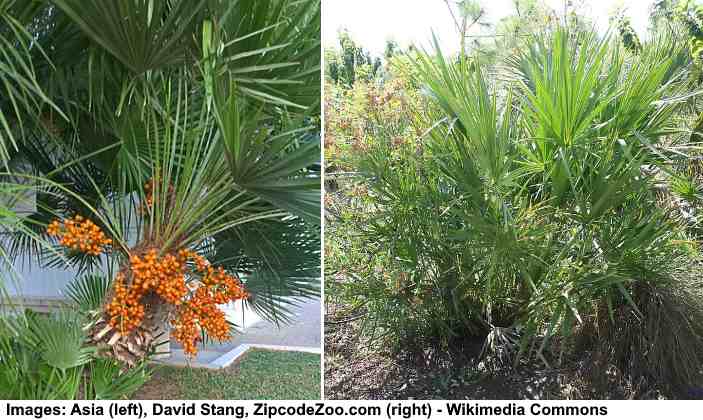
The small saw palmetto tree is suitable for limited spaces
The saw palmetto is a multi-trunked, clumping palm tree that grows masses of fan-shaped, palmate fronds that emerge from spined petioles. The waxy evergreen palm leaves grow 3 ft. (1 m) in diameter. Each bluish-green or emerald-green leaflet has 18 to 30 pointed segments. The palm also blooms with fragrant, creamy white flowers.
Saw palmettos make excellent container plants when grown in large pots. Their salt-tolerance makes them great choices for planting in coastal gardens. They can also be grown as a privacy hedge, screen, foundation plant, or accent plant. Once established, they are also drought-tolerant.
The saw palmetto is a native Florida palm tree that thrives in USDA zones 9 to 11. It’s also a species of cold-hardy palm and can survive short spells as low as 20°F (-6 °C). The palm’s spreading habit, dense foliage, white flowers, and yellow berries make it a valuable landscaping palm tree.
Mature Size: 5 to 10 ft. (1.5 – 3 m)
USDA Hardiness Zones: 9 to 11
Sun Exposure: Full sun to partial shade
Queen Palm (Syagrus romanzoffiana)
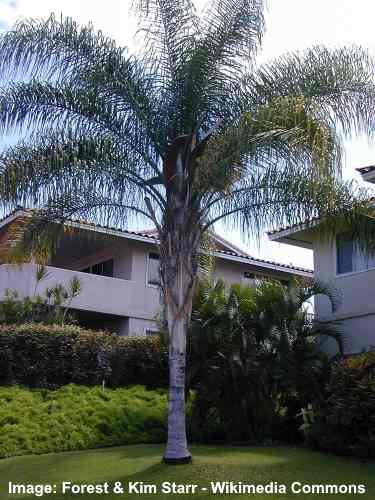
The queen palm is a popular ornamental tree for residential areas
The queen palm is a stylish evergreen tree identified by its super-long arching fronds. The feather-like fronds grow between 8 and 15 ft. (2.4 – 4.5 m) long and grow at the top of a slender, smooth, gray trunk. Other features of the queen palm include creamy-white flowers blooming in spring and clusters of yellowish-orange edible dates.
The queen palm is a sun-loving, heat-loving species that grows 50 to 70 ft. (15 – 21 m) tall. Despite thriving in the tropics, this fast-growing palm is also cold-hardy to 25°F (-4°C). The elegant palm tree grows best in moist, acidic soil and it has moderate salt tolerance.
The queen palm is tolerant of drought, salt, and high heat, making it excellent for planting in warm, coastal climates. This palm tree has tremendous ornamental value and is sure to add a tropical touch to any landscape.
Mature Size: 50 to 70 ft. (15 – 21 m)
USDA Hardiness Zones: 9 to 11
Sun Exposure: Full sun
Texas Sabal Palm Tree (Sabal mexicana)
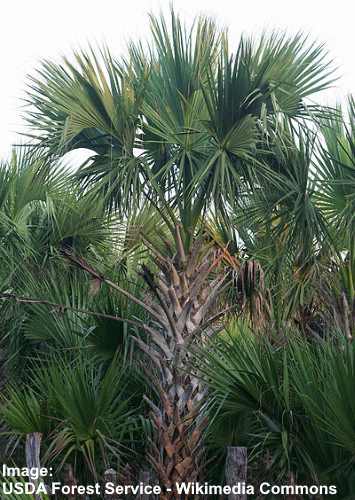
The Texas sabal palm is an attractive tree
Also called the Texas palmetto, the Texas sabal palm is a robust native Texas palm tree with a single trunk topped by large fan-shaped evergreen leaves. The attractive green palm fronds measure up to 6.5 ft. (2 m) wide, growing on 15 ft. (4.5 m) long stems, forming a thick, rounded crown. The sabal palm tree is also identified by clusters of creamy white flowers, and showy, black drupes.
The Texas sabal palm grows up to 50 ft. (15 m) tall and 25 ft. (7.6 m) wide. The Texas native tree is drought-tolerant and suitable for growing in USDA zones 8 to 11. The sabal palm thrives in high humidity, loamy, well-drained soils, and full sun. Plant it as a specimen tree to add visual appeal to garden landscapes.
Mature Size: 50 ft. (15 m) tall and 25 ft. (7.6 m) wide
USDA Hardiness Zones: 8 to 11
Sun Exposure: Full sun
Dwarf Palmetto Palm Tree (Sabal minor)
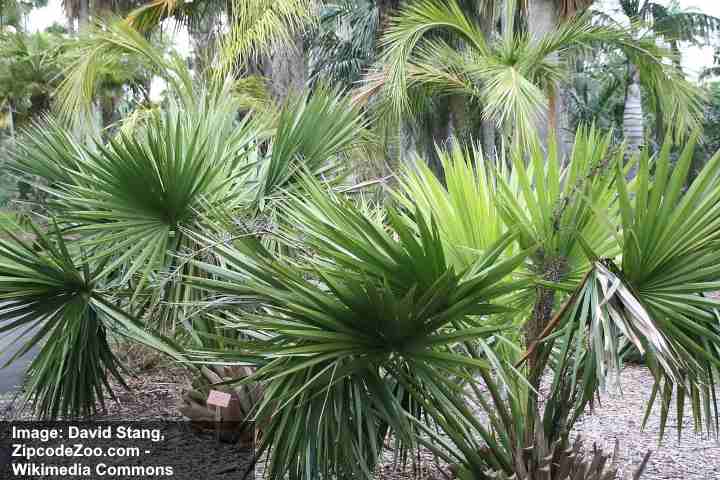
The dwarf palmetto can be found in many habitats and is a cold hardy small palm
The dwarf palmetto palm, native to central Texas and northeastern Mexico, has a shrub-like appearance. The flowering evergreen palm tree is identified by its shiny, blue-green fan-shaped leaves that sometimes grow straight from the ground. Its leaves with large, pointed segments measure 3 ft. (1 m) across and grow on smooth, spineless petioles.
Other identifying features of the dwarf palmetto palm are its fragrant, creamy-white flowers, and clusters of dark brown or black fruits.
Dwarf palmetto palm trees are drought- and salt-tolerant, suitable for growing in USDA zones 7 – 10. They are also cold-hardy down to 0°F (-18°C). The low-growing, shrub-like tree grows 4 to 5 ft. (1.2 – 1.5 m) tall and wide. Its ornamental value makes it useful for growing in warm climates as a foundation plant or textural accent.
Mature Size: 4 to 5 ft. (1.2 – 1.5 m) tall and wide
USDA Hardiness Zones: 7 to 10
Sun Exposure: Full sun to partial shade
Needle Palm Tree (Rhapidophyllum hystrix)
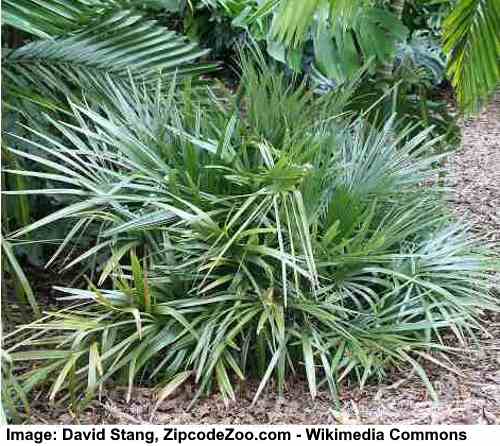
The needle palm is cold hardy and can grow as a miniature patio palm
The needle palm is a small shrub-like palm tree that grows between 3 and 6 ft. (1 – 1.8 m) tall. It has large, lustrous green leaves measuring 3 ft. (1 m) in diameter with up to 12 stiff, slender segments creating an open fan shape. During summer, the palm showcases charming clusters of small, yellow-brownish flowers.
The needle palm is cold-hardy, capable of withstanding temperatures down to 5°F (-15°C). It thrives in USDA zones 6 through 10. The palm’s dense foliage and low growth make it a versatile landscaping plant. It is drought-tolerant. Additionally, the shrubby palm grows just as well in full sun as in deep shade.
You can use the ornamental palm as an evergreen ground cover or focal point in a shade garden. It makes a great privacy screen or hedge. Additionally, it can be grown as a foundation plant, border plant, or container plant.
Mature Size: 3 to 6 ft. (1 – 1.8 m)
USDA Hardiness Zones: 6 to 10
Sun Exposure: Full sun to partial shade
Alexandra palm (Archontophoenix alexandrae)
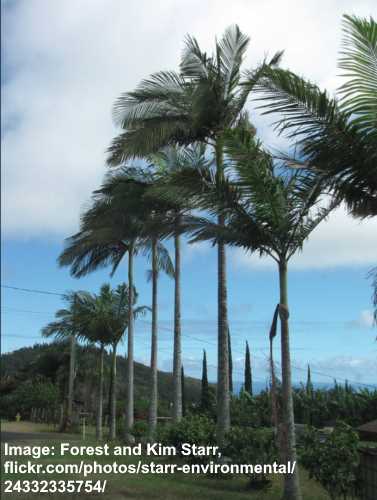
The Alexandra palm is a tall tree with a slender trunk suitable for tropical landscapes
The Alexandra palm is a tall, elegant palm tree that can grow up to 100 ft. (30 m) tall. This type of palm has the characteristic features of tropical palms. It has a large crown of arching feathery fronds on the top of a solitary gray trunk. Each frond has 80 lance-shaped leaflets.
Also called the king palm and feather palm, the tall tree thrives in full sun in USDA zones 10 through 12. However, it also grows in poor soils and soils with poor drainage.
Other identifying features of the Alexandra palm are its easily recognizable green crown shaft, clusters of white flowers blooming under the leaves, and large clusters of small round red fruits.
Mature Size: Up to 100 ft. (30 m)
USDA Hardiness Zones: 10 to 12
Sun Exposure: Full sun
Caribbean royal palm (Roystonea oleracea)
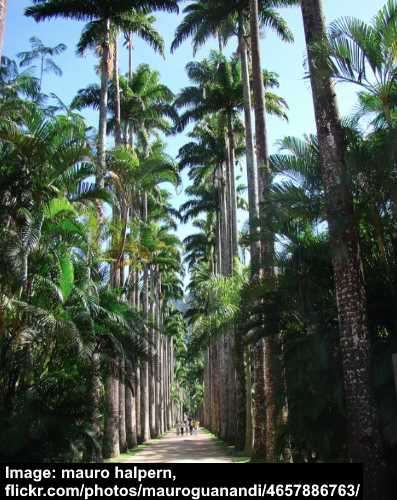
The Caribbean royal palm is a tall and beautiful tree and is suitable for warm climates
The Caribbean royal palm is a spectacular type of palm due to its columnar whitish-gray, straight trunk, large feather-like pinnate leaves, and huge clusters of small purple-blue edible fruits. Additionally, large sprays of white flowers contrasting with the green crown shaft add to this palm tree’s beauty.
This imposing tropical palm tree is common in warm climates like Florida and the Caribbean. The stately palm tree is 130 ft. (40 m) tall with an open crown consisting of 20 to 22 arching leaves 10 to 16 ft. (3 – 5 m) long.
Intolerant of cold weather, the Caribbean royal palm tree is only suitable for USDA zones 10 and 11. This spectacular tree is ideal as a street tree or ornamental landscaping tree.
Mature Size: 130 ft. (40 m)
USDA Hardiness Zones: 10 and 11
Sun Exposure: Full sun
Yellow Latan Palm (Latania verschaffeltii)
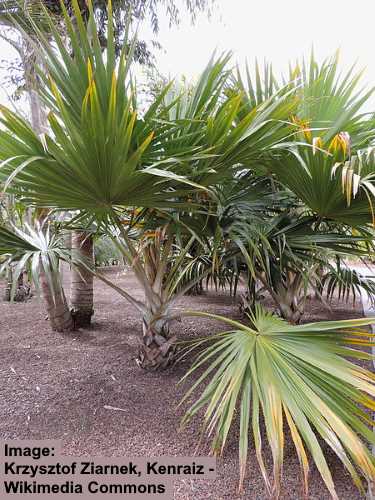
The yellow Latan palm tree has huge leaves and is slow growing
The yellow Latan palm tree is a tall, slender palm tree with a long gray stem and large leaves in the shape of a fan. The Latan palm tree grows between 36 and 50 ft. (11 – 15 m) tall. Its super-large palmate leaves are 6.5 to 10 ft. (2 – 3 m) wide, and the stiff pointed leaves grow on thick yellow petioles.
The slow-growing palm is native to Mauritius; however, it is cultivated throughout the world for its ornamental value.
Identifying characteristics of the yellow Latan palm tree are a slender gray stem, open crown, clusters of flowers, and brownish-green plum-shaped palm fruits measuring 2” (5 cm).
Mature Size: 36 and 50 ft. (11 – 15 m)
USDA Hardiness Zones: 9 to 11
Sun Exposure: Full sun
Blue Latan Palm (Latania loddigesii)
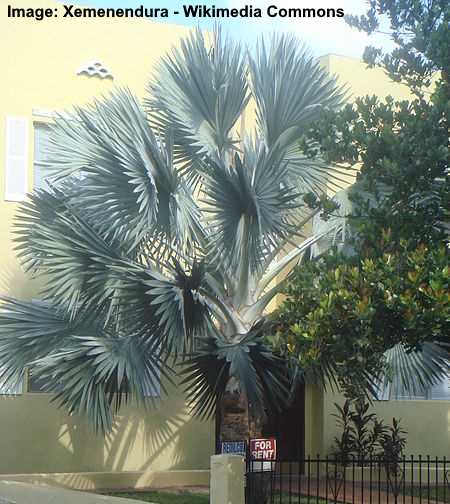
The blue Latan palm has an attractive silvery blue foliage and it looks great in any landscaped garden
The blue Latan palm tree is an attractive palm tree with enormous fan-shaped, bluish-green leaves forming the crown. This attractive landscaping palm tree is characterized by long, 6 foot (1.8 m) flower stalks, leaves with a woolly appearance, and large glossy brown palm fruits.
The blue Latan palm grows 20 to 25 ft. (6 – 8 m) tall with a crown 15 ft. (5 m) wide. The silvery-blue stiff leaflets have reddish margins and grow in a fan shape 8 ft. (2.4 m) wide, like the Bismarck palm tree.
The blue Latan palm tree is well suited to growing in USDA zones 10 and 11. The heat-loving palm tree performs best in full sun to partial shade, and, once established, it is tolerant to drought and salty air.
Mature Size: 20 to 25 ft. (6 – 8 m)
USDA Hardiness Zones: 10 and 11
Sun Exposure: Full sun to partial shade
San Jose Hesper Palm (Brahea brandegeei)
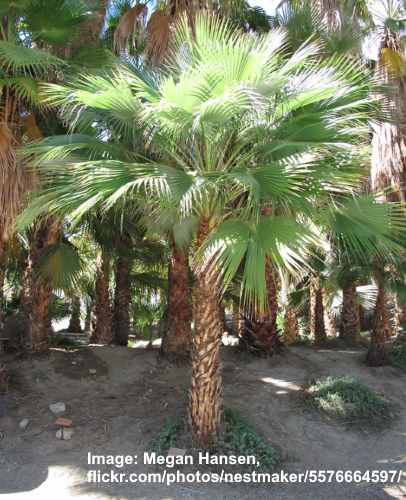
The San Jose hesper palm is a heat loving tree suitable for arid climates
The San Jose Hesper palm tree is native to Baja California and has an elegant, slender trunk and dense crown of arching feather-like leaves. The identifying features of this southern palm tree are the spiky leaf bases covering the upright trunk, 3-foot (1 m) long feather-like fronds, and short flower stalks.
This slow-growing, heat-loving palm tree is drought-tolerant and ideally suited to arid climates. The San Jose Hesper palm grows 40 to 60 ft. (12 – 18 m) tall. Its tolerance to drought and hot temperatures make it an ideal palm tree for growing in arid landscapes.
Mature Size: 40 to 60 ft. (12 – 18 m)
USDA Hardiness Zones: 10 to 11
Sun Exposure: Full sun
Flame Thrower Palm (Chambeyronia macrocarpa)
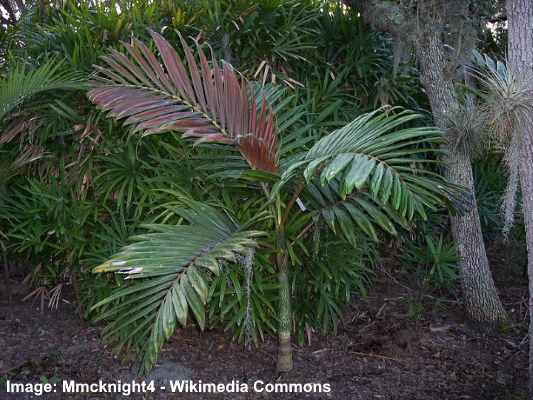
A young tree of flame thrower palm with reddish newly emerged leaf
The flame thrower palm tree is a single-stemmed palm with feather-like pinnate palm leaves, a bright green crown shaft, and clusters of small purple flowers, followed by bright red fruits. The unusual feature of this tropical palm tree is the newly emerged leaf that is red to maroon—hence the name “flame thrower” palm.
This slow-growing palm tree grows 20 to 25 ft. (6 – 7.6 m) tall with a crown 20 ft. (6 m) wide. In Southern California, the palm tree grows best in partial shade. However, the rare palm tree thrives in full sun in coastal areas along the Pacific Ocean.
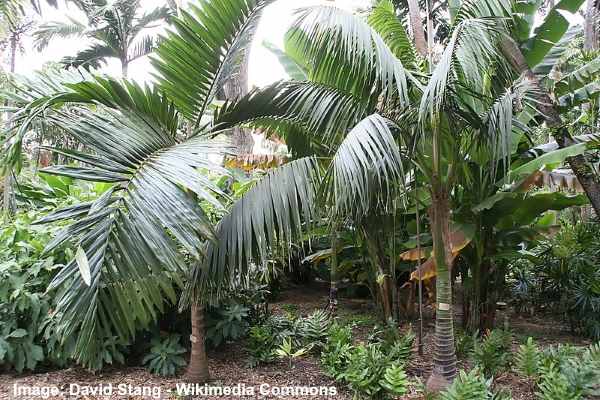
Mature trees of flame thrower palms
The unusual red leaf that emerges keeps its red color for 10 to 14 days before slowly turning green. Another feature of this palm tree is the grayish rings around a smooth green trunk.
Mature Size: 20 to 25 ft. (6 – 7.6 m)
USDA Hardiness Zones: 10 to 11
Sun Exposure: Full sun to partial shade
Loulu Palm Trees (Pritchardia spp.)
Loulu palm trees are native to Hawaii. They have a single trunk and are identified by large fan fronds on stalks measuring 2 to 10 ft. (0.6 – 3 m) long. Some species of Pritchardia have graceful arching branches with pleated round fronds. However, other varieties have drooping or weeping branches.
The fruits of Loulu palms are oval or spherical and grow in large clusters under the branches at the tree’s crown. The fruits can measure 0.75” to 2” (2 – 5 cm), depending on the species of the palm tree.
Some common species of Loulu palm trees include:
Pritchardia remota— A small palm tree endemic to the Hawaiian island of Nihoa that typically reaches 13–16 ft. (4–5 m) tall. It has a slim ringed trunk, dense crown with fan-shaped leaves with drooping tips, and small dark brown or black fruit.
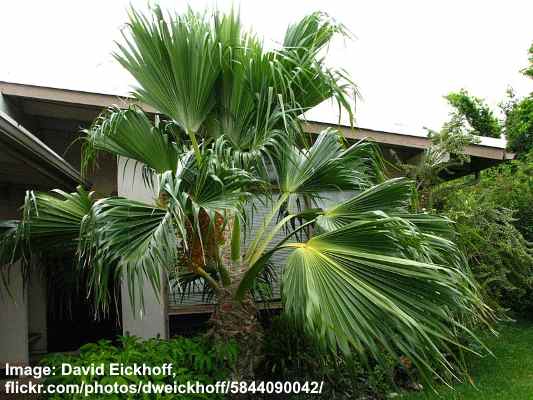
Pritchardia remota
Pritchardia munroi—A short Hawaiian palm growing 16 ft. (5 m) tall. It has drooping fan fronds that cover the entire tree, almost hiding the broad trunk from sight. It is native to dry and moist forests. Native to the Hawaiian islands Molokai and Maui.
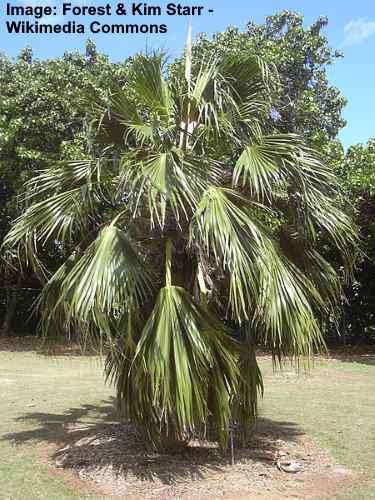
Pritchardia munroi
Pritchardia arecina—A medium-sized Hawaiian palm growing 30 to 50 ft. (9 – 15 m) tall. The large round palmate leaves measure 3 ft. (1 m) long on slightly arching stalks. Native to East Maui.
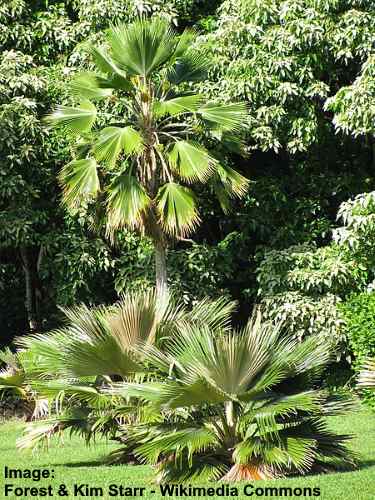
Pritchardia arecina
Pritchardia beccariana—This tall, slender palm is characterized by its smooth, gray stalk and spreading crown of flat fan fronds. The upper fronds extend at right angles from the crown shaft, whereas the lower ones tend to droop. The native palms are found on the eastern slopes of Mauna Loa on the Big Island.
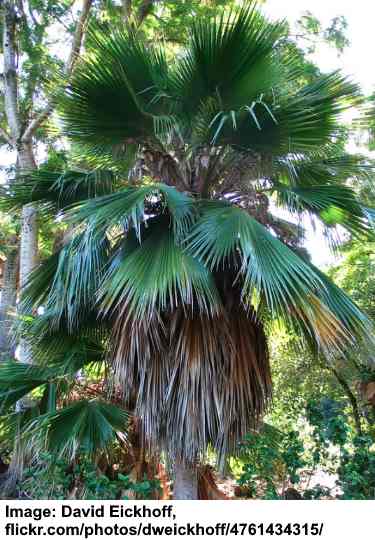
Pritchardia beccariana
Pritchardia glabrata—This slow-growing dwarf Hawaiian palm grows 6.5 to 16 ft. (2 – 5 m) tall. It has an open crown with fan leaves, each measuring about 2 ft. (0.6 m) long. Native to Lanai and West Maui.
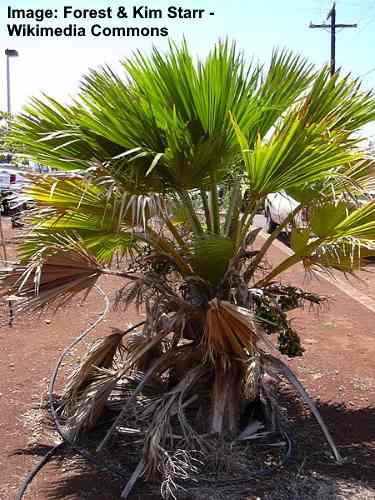
Pritchardia glabrata
Pritchardia lanigera—Native to Mauna Kea and Mauna Loa on the island of Hawaii, this exotic palm plant grows 50 ft. (15 m) tall with large, round fan fronds growing on relatively short petioles.
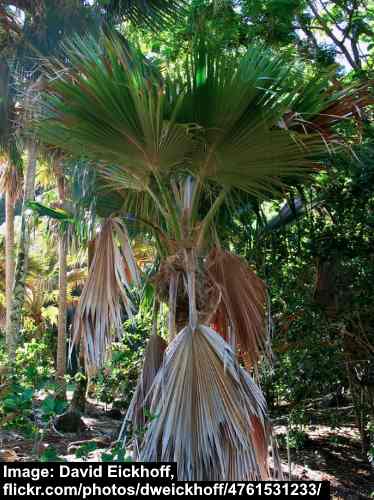
Pritchardia lanigera
Schattauer’s Loulu Palm (Pritchardia schattaueri) – a tall and rare palm tree native to Hawaii that grows an impressive 130 ft. (40 m) high. It has large fan-like fronds that grow 6 ft. (1.8 m) long and 7 ft. (2.1 m) wide. This distinctive palm tree has dead fronds, creating a skirt-like feature under the crown. Additionally, its trunk has a diamond-shaped pattern created by the leaf scars.
Schattauer’s Loulu palm is suitable for growing in USDA zones 10 to 12.
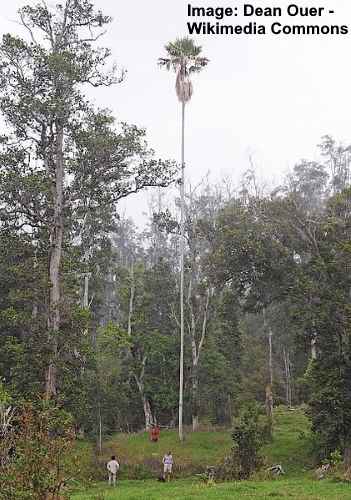
Schattauer’s Loulu Palm (Pritchardia schattaueri)
Carpentaria Palm (Carpentaria acuminata)
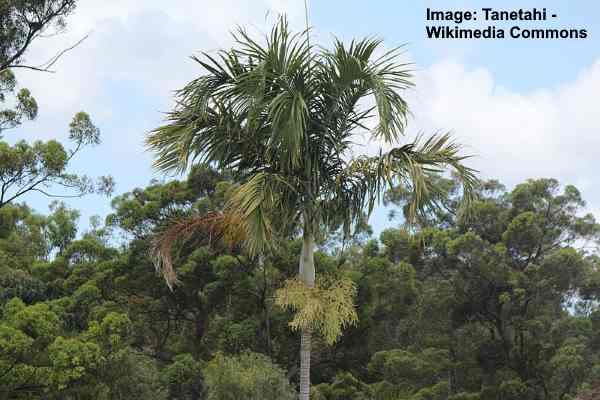
The carpentaria palm is characterized by a slim trunk and can grow very tall
The carpentaria palm is a sun-loving, fast-growing tropical tree commonly seen in Hawaii. The solitary palm has a slender, erect trunk with widely spaced rings, as well as a crown of large, arching, feathery fronds. The palm’s fronds measure 10 to 15 ft. (3 – 5 m) long and emerge from a smooth green crownshaft.
In spring, the carpentaria palm produces small, creamy-white flowers that are followed by round fruits that are scarlet red when ripe.
This ornamental carpentaria palm tree has a slender trunk that grows up to 30 to 100 ft. (9 – 30 m) tall and features large, feather-like fronds. The fronds are a bright green color and can grow up to 10 ft. (3 m) long.
Mature Size: 30 to 100 ft. (9 – 30 m)
USDA Hardiness Zones: 10 to 12
Sun Exposure: Full sun
Pigafetta filaris
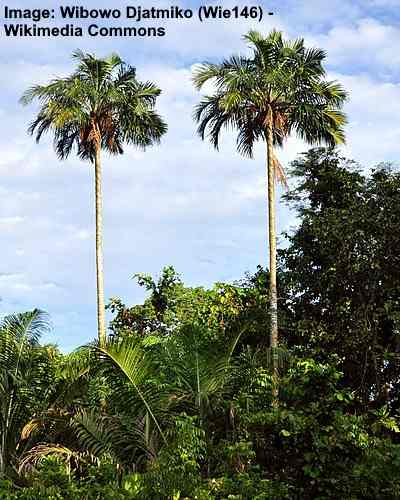
Pigafetta filaris is one of the tallest palms in the world, reaching up to 164 ft. (50 m)
Pigafetta filaris is a stunning, tall palm tree commonly seen growing in gardens and forests in Maui, Hawaii. Its trunk is slender, straight, dark green, and has white rings. With its large, arching, feathery fronds, it adds a touch of tropical elegance to any landscape or garden. The majestic palm’s fronds measure 20 ft. (6 m) long, with strap-like leaflets measuring 3 ft. (1 m).
The pigafetta filaris is a versatile palm tree that thrives in various soil conditions. It’s a fast grower in warm, humid conditions and needs consistently moist soil. These growth features make it ideal for growing in Hawaiian landscapes.
Mature Size: Up to 164 ft. (50 m)
USDA Hardiness Zones: 10 to 12
Sun Exposure: Full sun
Traveler’s Palm (Ravenala madagascariensis)
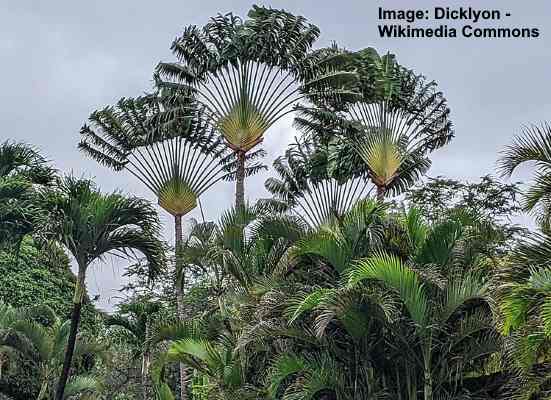
Traveler’s palms have uniquely shaped crowns and are not true palms
The traveler’s palm tree is an eye-catching flowering tree with massive paddle-shaped leaves that grow on long stalks. The leaf stalks are arranged in such a way that resembles a fan. The most recognizable feature of this tree is its unique fan-shaped crown consisting of up to 30 leaves per tree. Each leaf blade measures 5 to 10 ft. (1.5 – 3 m) long and 3 ft. (1 m) wide.
The traveler’s palm has several interesting features. First, it is thought to have gotten its name from the rainwater that accumulates at the cup-like base of the stalks. The water was thought to have been useful for travelers to drink in case of an emergency. Another unique feature is its distinctive white flowers, which are similar in shape to bird-of-paradise flowers.
Although called a palm tree, the traveler’s palm is not a “true palm” in the family Arecaceae. Instead, it is related to bird of paradise plants in the genus Strelitzia, and it has similar boat-shaped flowers.
Traveler’s palm thrives in frost-free areas and grows freely in Hawaii, the Florida Keys, and southern California.
Mature Size: Up to 30 ft. (9 m)
USDA Hardiness Zones: 10 to 11
Sun Exposure: Full sun
Real Fan Palm (Hyphaene petersiana)
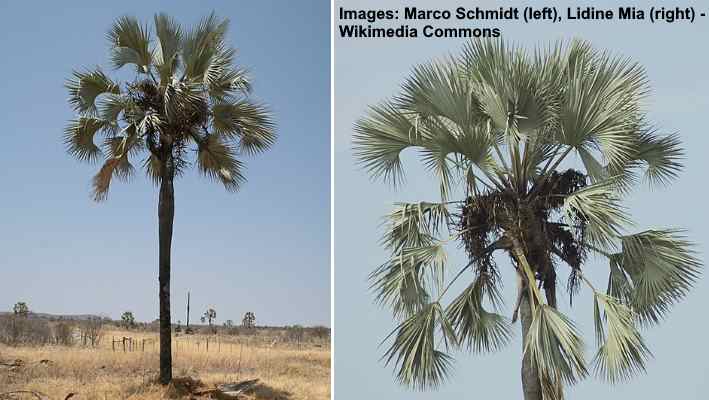
The real fan palm is a medium-sized palm tree with a slender trunk and silvery-green fan-shaped fronds
The real fan palm is a large, heat-loving palm known for its gray-green, fan-shaped leaves armed with sharp thorns on their petioles. It produces large, red-brown, round fruits that contain a hard white nut.
The palm is slow-growing, usually reaching up to 23 ft. (7 m) tall, though some specimens can grow up to 65 ft. (20 m) tall. The leaves are usually around 6.5 ft. (2 m) long.
Mature Size: Up to 65 ft. (20 m), usually around 23 ft. (7 m)
USDA Hardiness Zones: 9b to 11
Sun Exposure: Full sun
Quindío Wax Palm (Ceroxylon quindiuense)
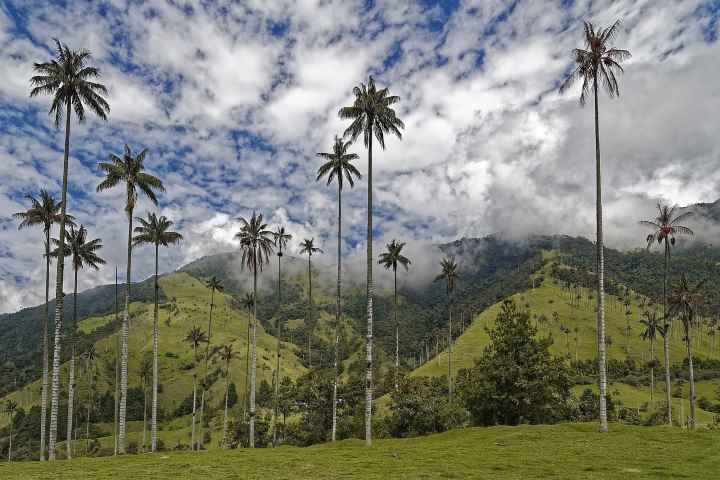
The Quindío wax palm is the tallest palm in the world and can be found in the warmest zones in USA
The Quindío wax palm, the world’s tallest palm species, can grow up to 200 ft. (60 m) in height. It has a slender gray trunk with diamond-shaped leaf scars and a thick wax layer. Its large feather-like fronds range from 6 to 18 ft. (1.8 – 5.5 m) long.
The flowers of the Quindío wax palm form dense clusters of creamy white blossoms, followed by small, round fruits that turn orange-red when ripe. The fruits are often eaten by parrots.
This sun-loving plant thrives in warm climates within USDA zones 10 and 11. The tallest palm trees in the world are native to the Andes of Colombia. Quindío wax palms can also be seen in some parks in California.
Mature Size: Up to 200 ft. (60 m), usually around 148 ft. (45 m)
USDA Hardiness Zones: 10 and 11
Sun Exposure: Full sun
Caranday Palm (Copernicia alba)
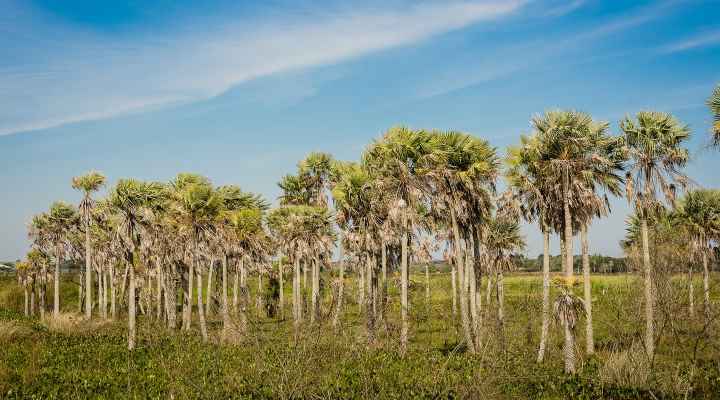
The tall Caranday palm is identified by its slender and smooth trunk and fan-shaped leaves
The Caranday palm reaches heights of 35 to 40 ft. (10.5 – 12 m). It has a slender trunk with a dense crown of silver-gray fan-shaped leaves measuring 5 ft. (1.5 m) long.
The Caranday palm blooms with small white or creamy-white flowers in spring, followed by small black fruits in summer. This versatile palm tolerates drought, wet soil, and heat, thriving in tropical landscapes.
The Caranday palm is cold-hardy down to 25°F (-4°C), making it the cold-hardiest palm in the Copernicia genus. It can be planted in USDA zones 9-11.
Mature Size: 35 to 40 ft. (10.5 – 12 m)
USDA Hardiness Zones: 9 to 11
Sun Exposure: Full sun
Sugar Palm (Arenga pinnata)
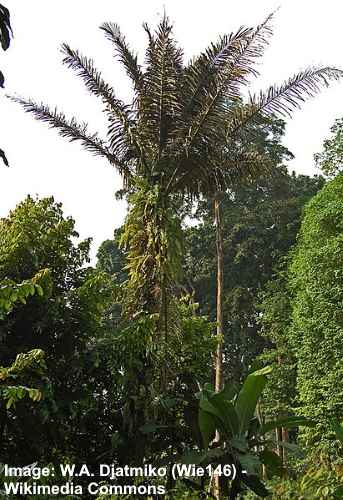
The tall sugar palm is salt and wind tolerant and is suitable for tropical coastal regions
The sugar palm is a tropical tree that grows up to 70 ft. (21 m) tall. It has large fan-shaped leaves up to 40 ft. (12 m) long and produces clusters of small yellowish-green flowers and edible fruits.
Native to Southeast Asia, it thrives in full sun or partial shade, tolerates salt and strong winds, making it suitable for coastal gardens. It can be planted in USDA zones 10 and 11.
Mature Size: Up to 70 ft. (21 m)
USDA Hardiness Zones: 10 and 11
Sun Exposure: Full sun to partial shade
African Fan Palm (Borassus aethiopum)
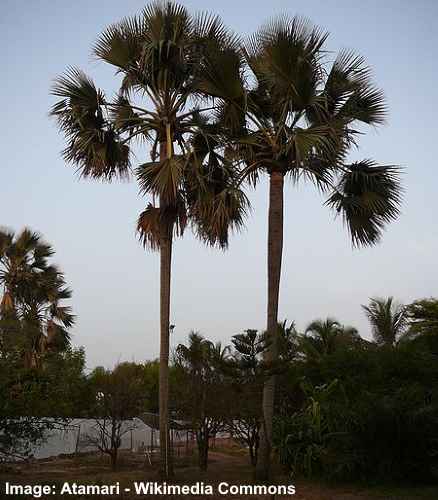
The African fan palm is a tall majestic tree that is a focal point in tropical gardens
The African fan palm grows up to 82 ft. (25 m) tall with fan-shaped leaves measuring 10 ft. (3 m) long. It features a thick cylindrical trunk with deep grooves and clusters of large yellow flowers and edible fruits.
Ideal for warm, sunny climates, the African fan palm adds a captivating centerpiece to tropical landscapes. It is suitable for USDA zones 10 and 11.
Mature Size: Up to 82 ft. (25 m)
USDA Hardiness Zones: 10 and 11
Sun Exposure: Full sun
American Oil Palm (Attalea butyracea)
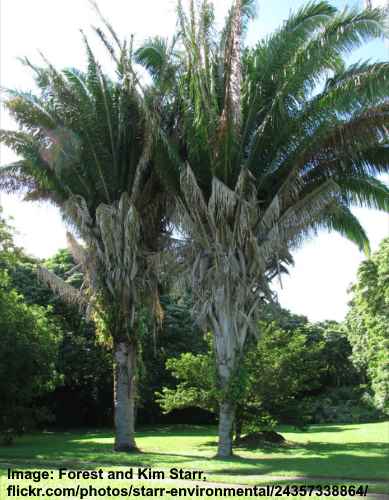
The tall American oil palm has an impressive crown and looks stunning in tropical landscapes
The American oil palm is a tall tropical tree that can reach a height of 82 ft. (25 m). It has large feather-like leaves measuring 20 ft. (6 m) long and 3 ft. (0.9 m) wide. The crown of the palm consists of up to 35 arching leaves, while the trunk is straight, cylindrical, and unbranched.
This palm is a magnificent addition to large landscapes, parks, and gardens, making it suitable for planting in USDA zones 10 and 11.
Mature Size: Up to 82 ft. (25 m)
USDA Hardiness Zones: 10 and 11
Sun Exposure: Full sun
Canala Palm (Kentiopsis oliviformis)
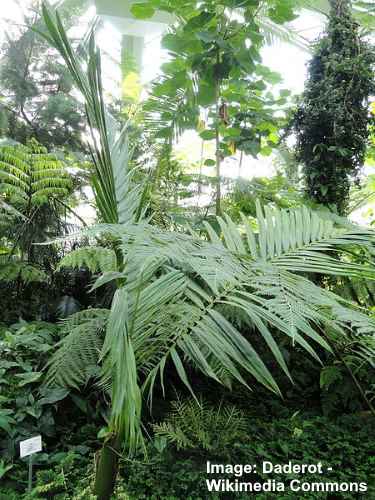
A young Canala palm tree
The Canala palm is a towering tree, reaching over 100 ft. (30 m) in height. It has an arched crown of long, feather-like fronds measuring 10 ft. (3 m) long. The trunk is slightly swollen at the base, green in color, and has white rings caused by leaf scars. The palm produces large clusters of fruits below the crown.
It thrives in warm, humid climates and is perfect for poolside plantings, tropical gardens, and as a specimen plant. Once established, it is fast-growing. It can be planted in USDA zones 10 and 11.
Mature Size: 100 ft. (30 m)
USDA Hardiness Zones: 10 and 11
Sun Exposure: Full sun
Bay-Leaf Palm (Sabal mauritiiformis)
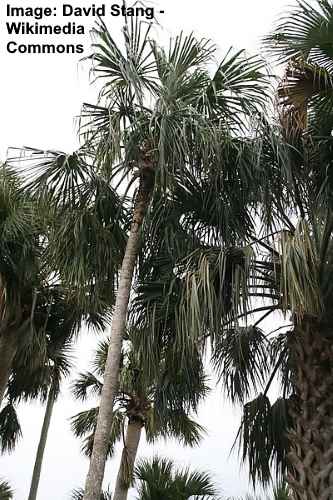
The bay-leaf palm is a slow growing tall tree with fan-shaped fronds
The slow-growing bay-leaf palm tree loves the sun and can reach a height of 65 ft. (20 m). It is characterized by its slender, gray trunk that is enlarged at the base, impressive irregular crown formed by fan fronds, and pear-shaped black fruits.
The bay-leaf palm’s leaves are a deep green color above and a silvery-green color below. The palm also produces large clusters of tiny white flowers. The crown typically consists of 10 to 25 fronds.
Thriving in full sun and well-drained, organically rich soil, the bay-leaf palm is an excellent choice as a specimen tree, accent plant, or for creating tropical landscapes. It is tolerant of salty winds, meaning it can be grown in coastal landscapes without trouble. It is also drought-tolerant and low-maintenance once established, and can be grown in USDA zones 9-11.
Mature Size: Up to 65 ft. (20 m)
USDA Hardiness Zones: 9 to 11
Sun Exposure: Full sun
Indoor Palm Trees (With Pictures and Names)
Many types of ornamental palm trees look beautiful indoors and can provide attractive greenery. Some types of indoor palm plants can be grown in containers in conservatories. Many types of indoor palm tree plants thrive at home, and their ‘mini’ or ‘baby’ size makes them a good addition to your houseplants.
Here are some types of palms that grow well indoors.
Parlor Palm (Chamaedorea elegans)

The Parlor Palm is a small low maintenance tropical palm tree. It is also considered to be one of the lucky plants according to the Feng Shui
The parlor palm is a small-growing bushy tropical palm tree with reed-like slender stems with light-green pinnate leaves growing on them. The palm produces small, round black fruits and tiny yellow flowers. Each stem has 6 or 7 leaves that give the palm a bushy appearance when a few grow together. Usually, in tropical outdoor areas, these small palm trees grow up to 9 ft. (2.7 m) tall.
Due to its small size of around 6 ft. (1.8 m), the parlor palm is often grown indoors as a houseplant. The palm has been found to purify the air by filtering airborne toxins such as benzene and formaldehyde. When growing indoors, make sure to place it in filtered sunlight, as direct sunlight may scorch the leaves.
The parlor palm is also often grown as a potted palm outdoors around patios, decking areas, or outdoor pools. It is also a very low-maintenance indoor evergreen that can even survive in low-light and dark conditions.
Mature Size: Around 6 ft. (1.8 m), rarely taller
USDA Hardiness Zones: 10 to 12
Sun Exposure: Indirect sun or shade
Kentia Palm (Howea forsteriana)
Although the Kentia palm tree can grow up to 40 ft. (12 m) outdoors, indoor varieties of this palm will max out at about 12 ft. (3 m) tall. It is commonly grown in California. The palm showcases white flowers that give way to red, egg-shaped fruits. Because they are a slow-growing species of palm, they are an excellent choice to grow indoors.
The Kentia palm tree has thin green stems with large palm-shaped leaves that can provide a tropical atmosphere to any kind of room. The palm makes a great container plant when grown in a pot outdoors on a patio, deck, or shady area. Cold-hardy down to 25°F (-3°C). The ability for Kentia palms to withstand low-light, infrequent watering, low humidity, and cool to warm temperatures make them a perfect indoor type of palm.
Mature Size: Up to 40 ft. (12 m)
USDA Hardiness Zones: 9b to 11
Sun Exposure: Indirect sun or shade
Lady Palm (Rhapis excelsa)
The lady palm is a type of multi-stemmed leafy plant that has a gorgeous bushy appearance and can grow up to 13 ft. (4 m) in height. The palmate leaves are dark green and glossy and have unique saw-tooth leaf tips. The palm produces clusters of small, bowl-shaped yellow flowers and fleshy, white fruits. The multiple, cane-like, slender stems of this palm look similar to some types of indoor bamboo plants.
The lady palm’s dense foliage makes it a great choice for planting as a privacy screen or hedge. It is slow-growing, low-maintenance, and cold-hardy down to 18ºF (-7ºC). The palm can also be grown in pots in a shaded area. It is recommended to grow this palm in partial or full shade for optimal results, as direct sunlight may scorch the lAbout TablePresseaves.
Mature Size: Up to 13 ft. (4 m)
USDA Hardiness Zones: 9 to 11
Sun Exposure: Indirect sun or shade
Ponytail Palm (Beaucarnea recurvata)
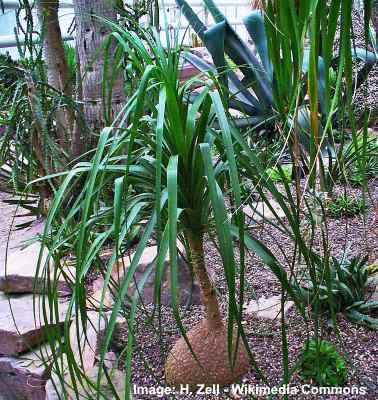
The Ponytail palm tree can grow tall outdoors. But is also suitable to be grown in a container indoors as an indoor palm plant
The Ponytail palm tree (Beaucarnea recurvata) is one of the most ornamental indoor palms you can have in your room. Other common names for this plant include bottle palm tree or elephant foot tree.
The ponytail palm tree is neither a palm nor a tree. It’s actually a type of succulent and a member of the Agave family.
The Ponytail Palm plant can be identified by its thick, brown, swollen base of the stem. This distinctive feature is a reason why it’s also called the elephant’s foot palm. The base of the stem actually stores water, making the palm exceptionally drought-tolerant. Other identifying features include summer-blooming, creamy-white flowers and small, round, reddish fruits.
At the end of the ponytail palm’s short, fat palm stem is a fountain of beautiful, thin, green, arching leaves. This bushy display of green foliage makes for an attractive indoor tropical palm in sunny locations.
Mature Size: Up to 30 ft. (9 m) outdoors, up to 6 ft. (1.8 m) indoors
USDA Hardiness Zones: 10 to 11
Sun Exposure: Full sun
Areca palm (Dypsis lutescens)
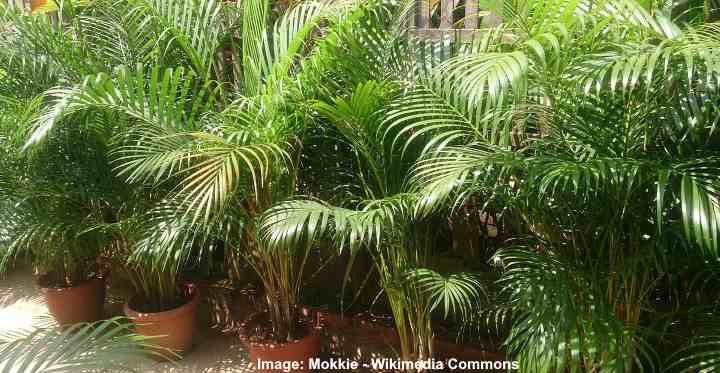
The areca palm is a type of indoor palm plant that will give a tropical look to any space
The areca palm is a multi-stemmed plant with arching fronds 3 ft. (1 m) long, yellow summer flowers, and small yellow-orange palm fruits. This palm has an identifiable butterfly shape due to the multiple stems of palm leaves that curve upward. The areca palm grows 20 – 40 ft. (6 – 12 m) outdoors in tropical climates.
In colder climates, the areca palm plant is an attractive evergreen ornamental houseplant. The long arching stems can grow around 6 ft. (1.8 m) tall. The delightful potted palm leaves have lance-shaped leaflets that grow up to 6” (15 cm) long.
Other common names for Dypsis lutescens refer to the palm’s growth habit and flowers. You may hear this palm called the bamboo palm, golden feather palm, cane palm, or yellow palm.
Mature Size: 20 – 40 ft. (6 – 12 m) outdoors, shorter indoors
USDA Hardiness Zones: 10 to 11
Sun Exposure: Indirect sun
Further reading: Growing Areca Palm Tree Indoors – Care Guide.
Related articles:
- Indoor Palm Plants (Including Care Guide)
- Impressive Small or Dwarf Palm Trees
- The Best Types of Palm Trees in Florida

